
The ferry leaves South Andaman Island for the crossing of Middle Strait.
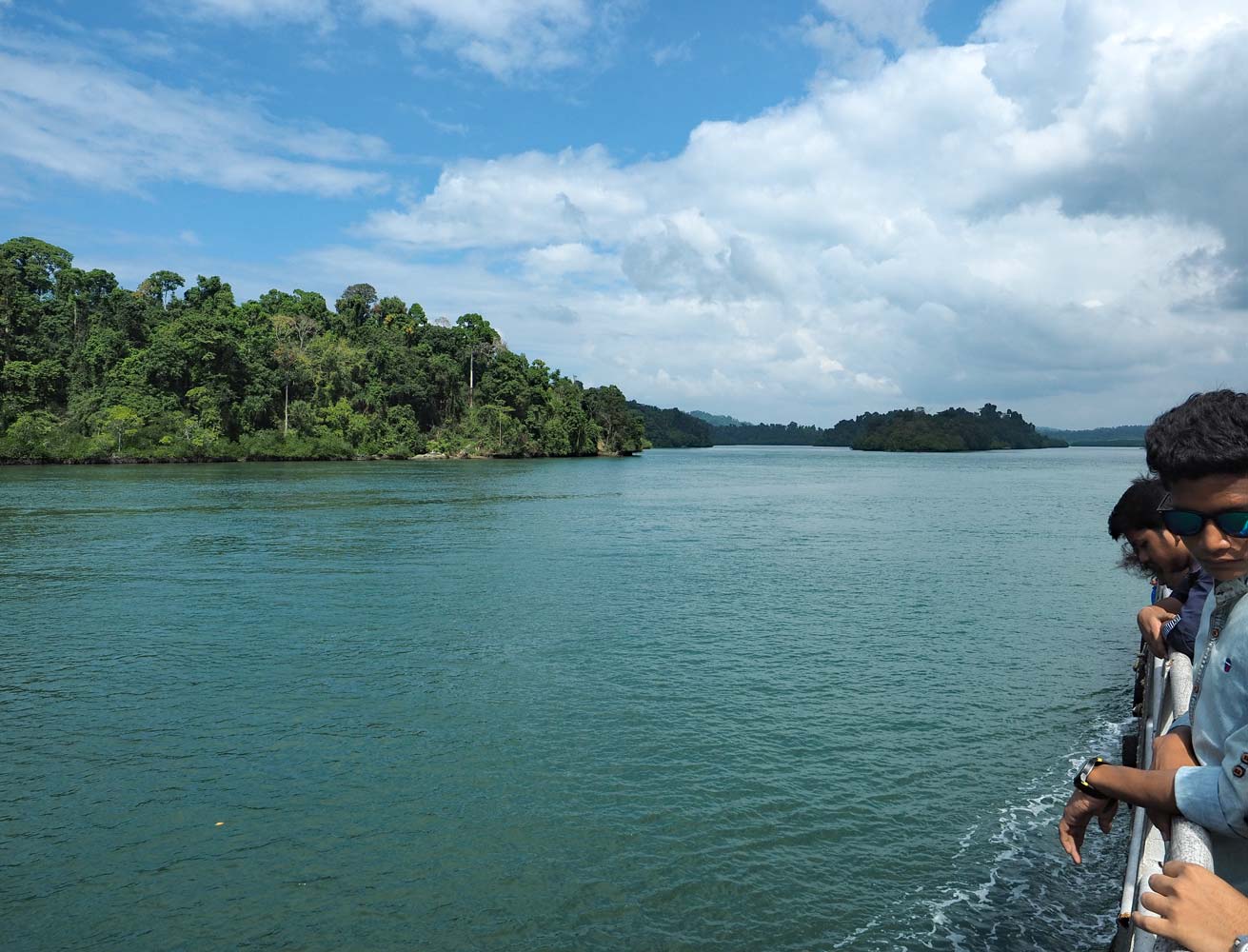
Middle Strait view
14 Dec. Long Island (Blue Planet)
I got an early start for what would be a
long day of travels by walking to the bus station for the 6:45 a.m. departure. My
‘express’ bus of the Andaman & Nicobar Administration State Transport Service
wandered south, then west on a long swing around the bay before beginning the trek
north. The outskirts of Port Blair extend far from the center, and we made a few
stops to pick up more passengers. As befits a basic Indian bus, this one had a rock-hard
suspension so that passengers could feel every irregularity of the road’s surface,
and the beat-up pavement had non-stop irregularities. Seated on the next-to-last
row, I would go airborne on the biggest bumps. Beyond town the bus rolled past farms
and lots of coconut and betel palms. Farther north on the NH4/Andaman Trunk Road,
we tunneled through a pristine jungle of towering trees. This would have been a
great ride on a bicycle except for one problem—the highway controversially passes
through tribal areas of the Jarawa—and interactions between the tribe and Indians
have gone badly at times in the past. A policeman on a motorbike led my bus and
two others for a long stretch. I only saw one recognizable tribal man, a negrito
who wore a braided headband. At about the 100-kilometer point, the bus reached Middle
Strait on the north edge of South Andaman Island, then rolled onto a ferry just
big enough for the three buses. The ferry docked at the settlement of Baratang on
Baratang Island, where I saw speedboats carrying tourists, no doubt on an excursion
to nearby limestone caves and a mud volcano.

The ferry leaves
South Andaman Island for the crossing of Middle Strait.

Middle Strait view
Something wasn’t right with the bus, so the driver pulled into a bus depot for mechanics to have a look, then we continued half an hour later. In 23 kilometers we reached the northern end of Baratang Island at Gandhighat Jetty and another ferry, which cheekily charged each passenger 10 rupees, and dropped us off at Uttara on Middle Andaman Island. On the 50-kilometer ramble to Rangat, the jungle gradually gave way to farms, then the market town itself. When the bus came to its final stop, people pointed out the spot where transport would be available to Yeratta Jetty and a ferry to Long Island. I got on a Mahindra passenger truck (20 rupees) with other travelers and we bumped south about 8 kilometers down a narrow lane to the jetty, set amid mangroves. I took a stroll out a boardwalk over the mangroves, then returned to the pier to see a rusty old boat, the M.V. Bulbul, puff black clouds of diesel smoke as it docked. The slow and beautiful journey to Long Island began along a narrow channel through the mangroves, where one of the crew spotted a crocodile, then entered a wide channel. We passed small islands on the lake-like water and docked at a pier at the southwest corner of Long Island. The hour-long excursion cost only 20 rupees.

Fishing boats tie
up near Yeratta Jetty.

We follow this
channel through the mangroves.
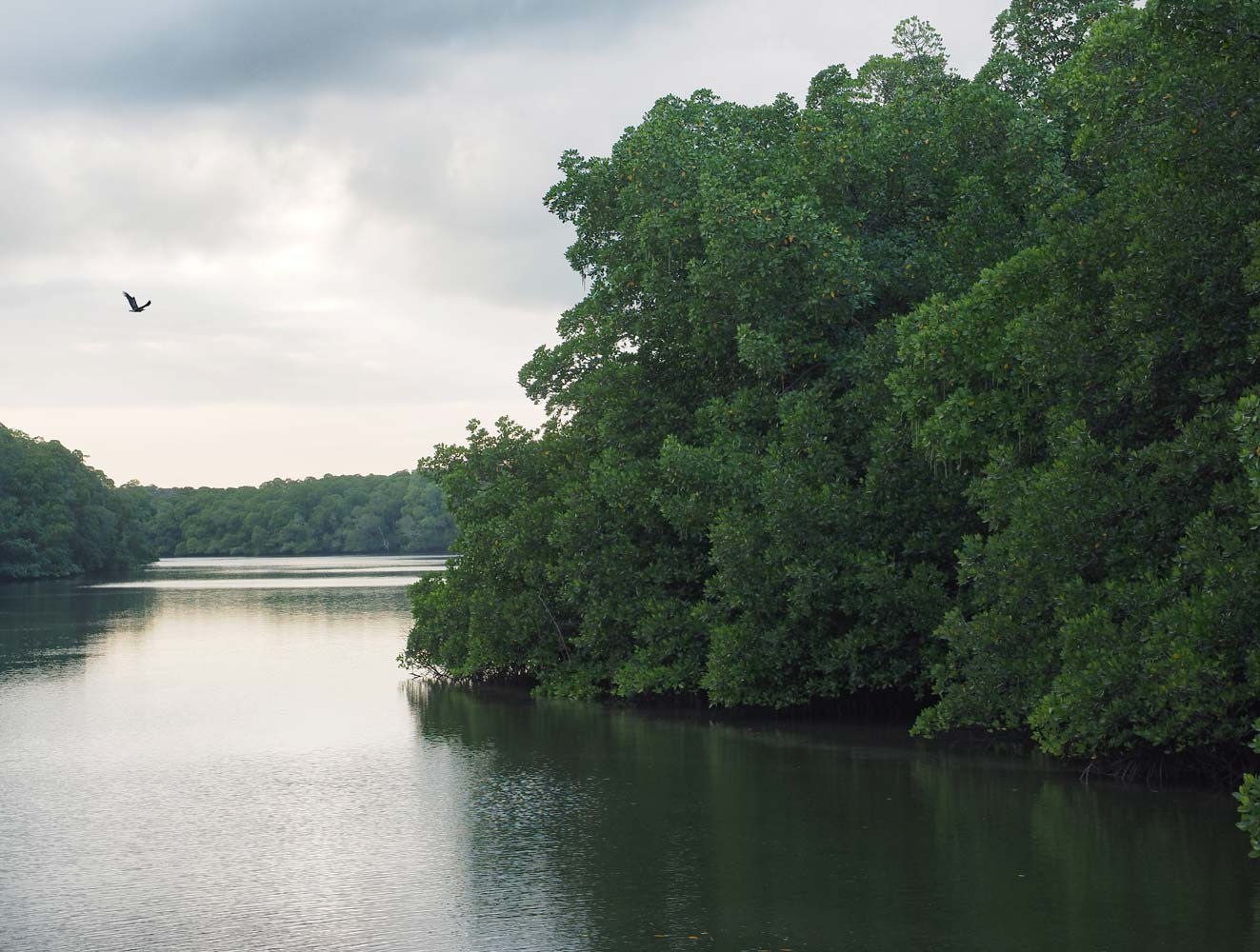
Another view of the
channel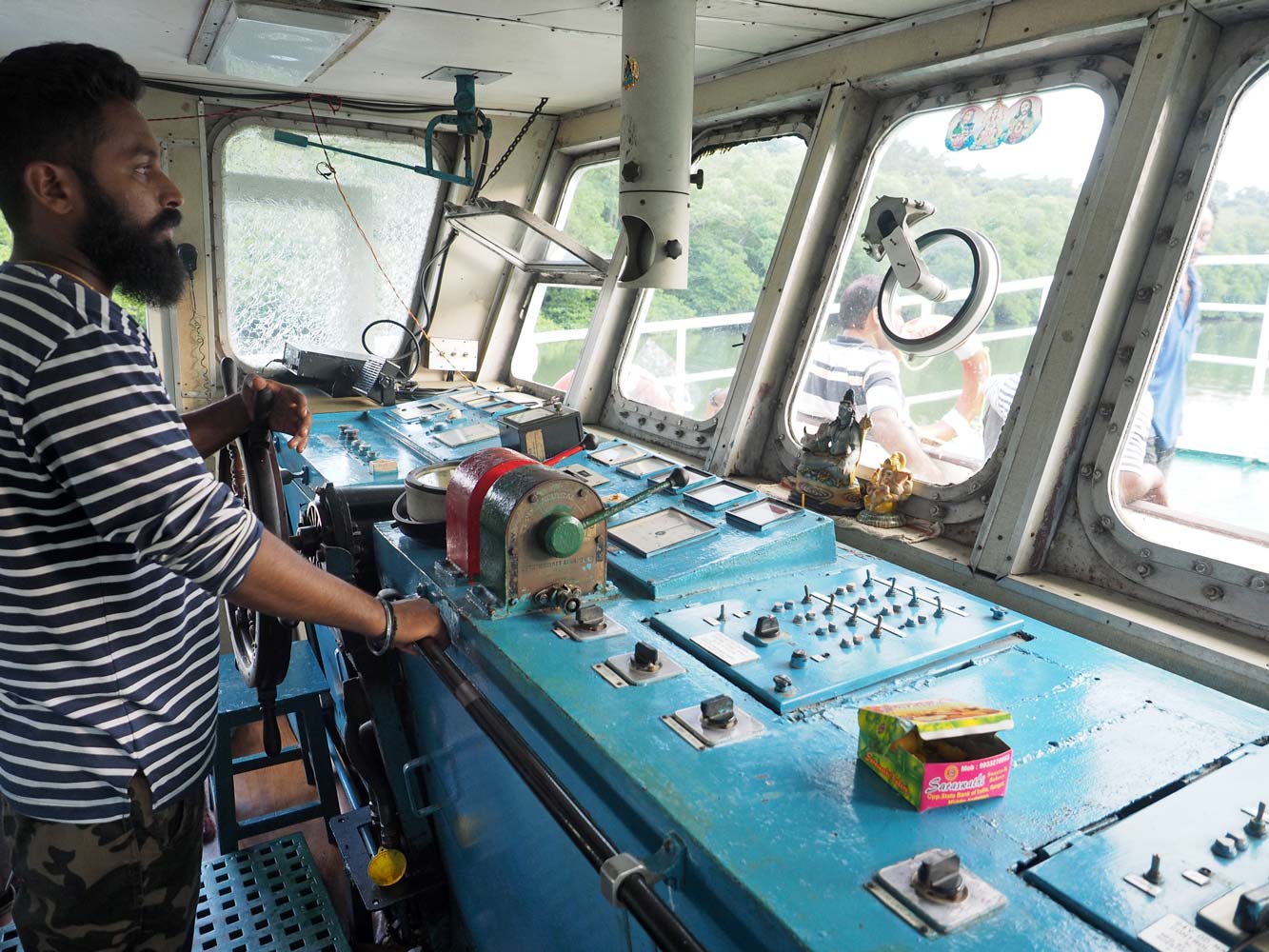
Our
captain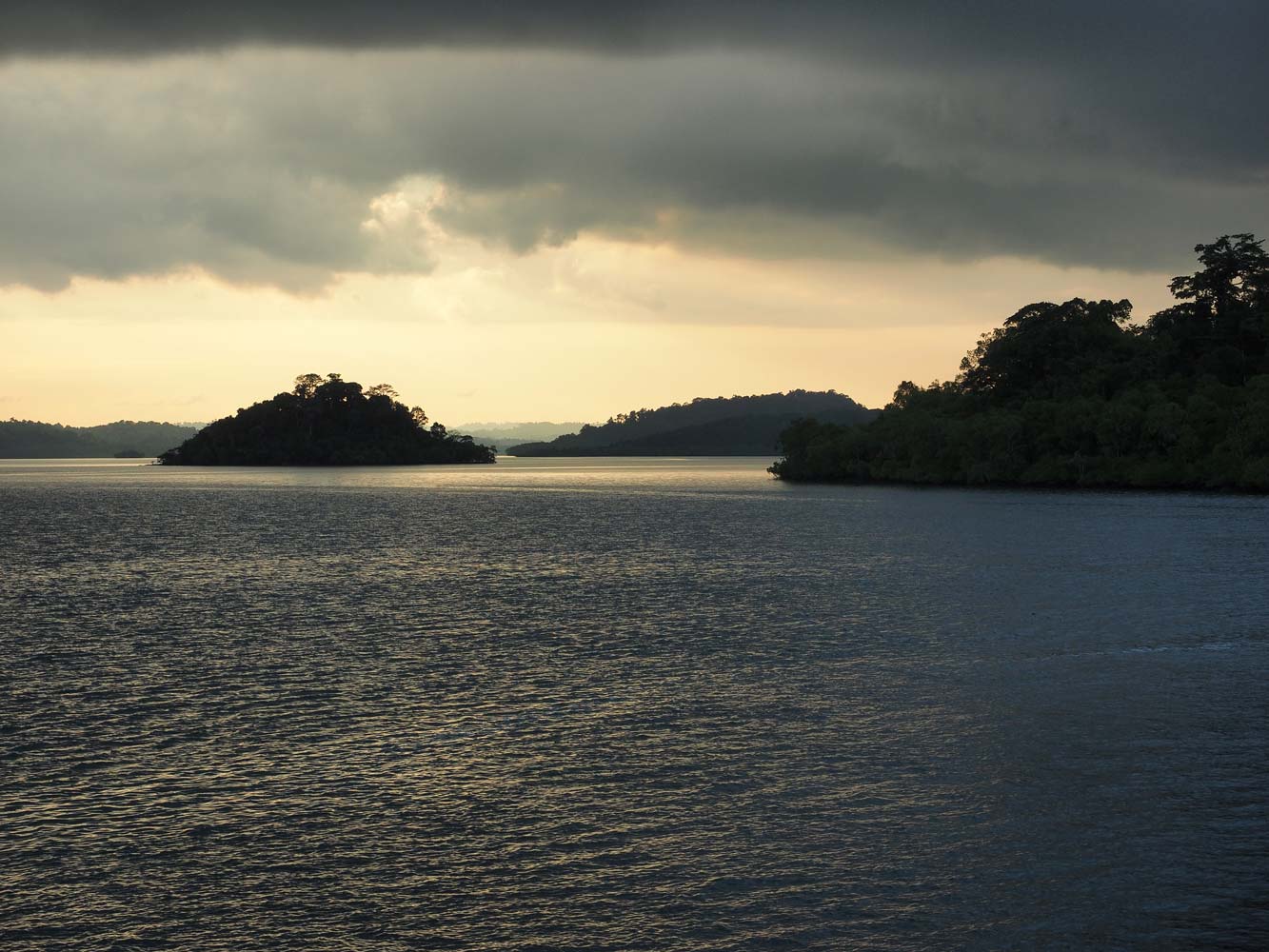
The
channels widen as we near Long Island.
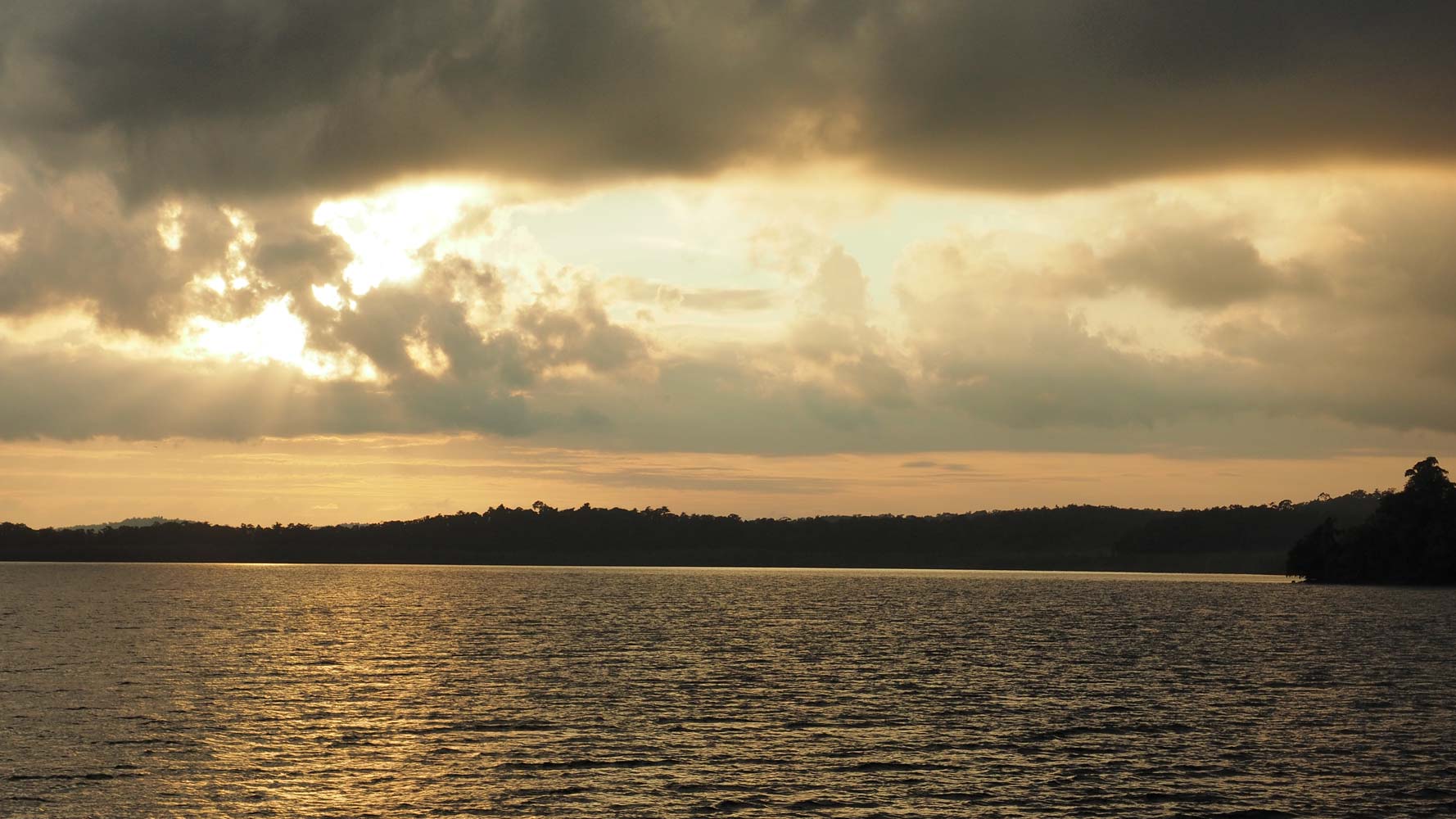
Late afternoon glow
near journey’s end
A policeman at the pier checked my passport and Restricted Area Permit, then I met
a young fellow with Blue Planet, a rustic resort set around a huge paduak tree,
who gave me a ride on his motorbike to the resort. (If you walk the 1.5 kilometers,
follow the blue arrows on the pavement.) Two Western couples, the first foreigners
I had seen all day, were also staying here. Blue Planet
www.blueplanetandamans.com is the
only place to stay on the island and has basic huts with a mattress on the floor
and outside bathrooms at 500 rupees, larger rooms with bath at 1500 rupees and up,
and two contented cats. I splurged on a 1500-rupee room, though it turned out to
have those awful woven bamboo upper walls that carry every sound the neighbors make,
though fortunately the neighbors were relatively quiet that night. I sat down for
dinner of vegetable kolapuri, a very spicy North Indian dish. The resort manager
worried that it was too hot and even offered to exchange it for something milder,
but I was happy enough with the veggies in their fiery red sauce. Afterward I cooled
down with a fruit salad, a lemon-sugar pancake, and a glass of milk tea. Blue Planet
offers scuba diving, something I was hoping to do, but the short season here won’t
begin for another two weeks. A small library included an Indian produced guidebook
to the Andamans, but it was heavy on government statistics (Total length of high-tension
wires in the islands, anyone?) and weak on sights and activities.
15
Dec. Long Island (Blue Planet)
I decided to take things easy on this pleasant
sunny day, but tomorrow I planned on doing the 1.5-hour hike to Lalaji Beach, a
sandy crescent far up the eastern shore. One needs a permit from the forestry office
to go here, so after breakfast I walked over (The office is near a tea shop about
300 meters before the pier.) and got the free permit for tomorrow’s hike. Next I
walked through the very sleepy center where small shops housed in shacks line the
empty road, then continued along the ballfield where goats and cows grazed and teachers
lined up their small charges for activities. I took a road past some houses and
government offices, then followed a grassy path beside the shore and onto a sandy
beach, mixed with rock and broken bits of coral. One of the couples staying at the
Blue Planet was catching the sun here. A set of pale-blue shrines just above the
beach had images of Hindu and local gods. Densely forested Guitar Island lay offshore,
and photos taken from the air show it having a remarkably guitar-like shape complete
with a circular pond for the instrument’s hole. Farther along I rounded a point
and turned up the east coast—more rock than sand—where a few locals tried their
luck with hand nets in shallow pools left by the low tide. The dark blue open sea,
topped with little white-capped waves, lay to the east and many islands hugged the
horizon to the southeast. I headed back toward the village, then turned inland on
a likely looking trail, which turned out to have yellow arrows that led me back
to Blue Planet. On the way I passed extensive concrete foundations—ruins of a plywood
factory that closed 15 years ago—I was later told. In the afternoon I made a lot
of progress sorting Ireland photos and choosing the best for later posting. Mixed
vegetables made for a tasty dinner. A chatty Indian couple and their beeping phone
next door made noise until late in the night.
16 Dec. Long Island (Blue
Planet)
On a pleasant sunny day I was ready to hit the hit the trail to Lalaji
Beach at 6 a.m., but that’s when the kitchen opened, so hung around for breakfast
of an omelet, butter toast, cornflakes, and tea. Finding the way to Lalaji Beach
turned out to be easy, and I could check the route on my phone with Maps.me. A few
red arrows pointed the way: from Blue Planet I turned north on the first right,
then walked past farms and pastures on concrete and dirt paths to a T-junction,
where I turned right (west) and continued straight into the forest at the next junction
and passed the last farm. The wide dirt trail curved north and passed through beautiful
jungle. Walking this trail was the best thing about visiting Long Island for me.
Many of the trees towered very high, and some even had labels with their Indian
and Latin names. Seed pods and flowers had dropped from the heights to the jungle
floor. Unseen birds sang and crickets chirped. Off to the west I got a couple glimpses
of the hazy sea and could hear the gentle surf. Small lizards darted about and I
found a large hermit crab. A biting sensation at the top of my left sock led to
discovery of a leech just starting to take hold. I checked the other leg, and sure
enough, another little leech had attached itself. The trail remained nearly level
until near the end when it began a long gradual descent to a coconut plantation
and Lalaji Beach. The hike had taken just over two hours, moving slowly and taking
lots of photos. Just last month visitor facilities including changing rooms and
toilets had opened, but I just strolled along the beach. Many large trees had washed
ashore onto the white sands. A hot sun made me glad to get back in the deep shade
of the jungle for the walk back. I hung out at the resort the rest of the day, then
had a vegetable kadai dinner, delivered sizzling in a bowl. Food is good here. In
the evening I wrote up the day’s adventures and sorted through all the Andaman photos
taken so far, about 200.
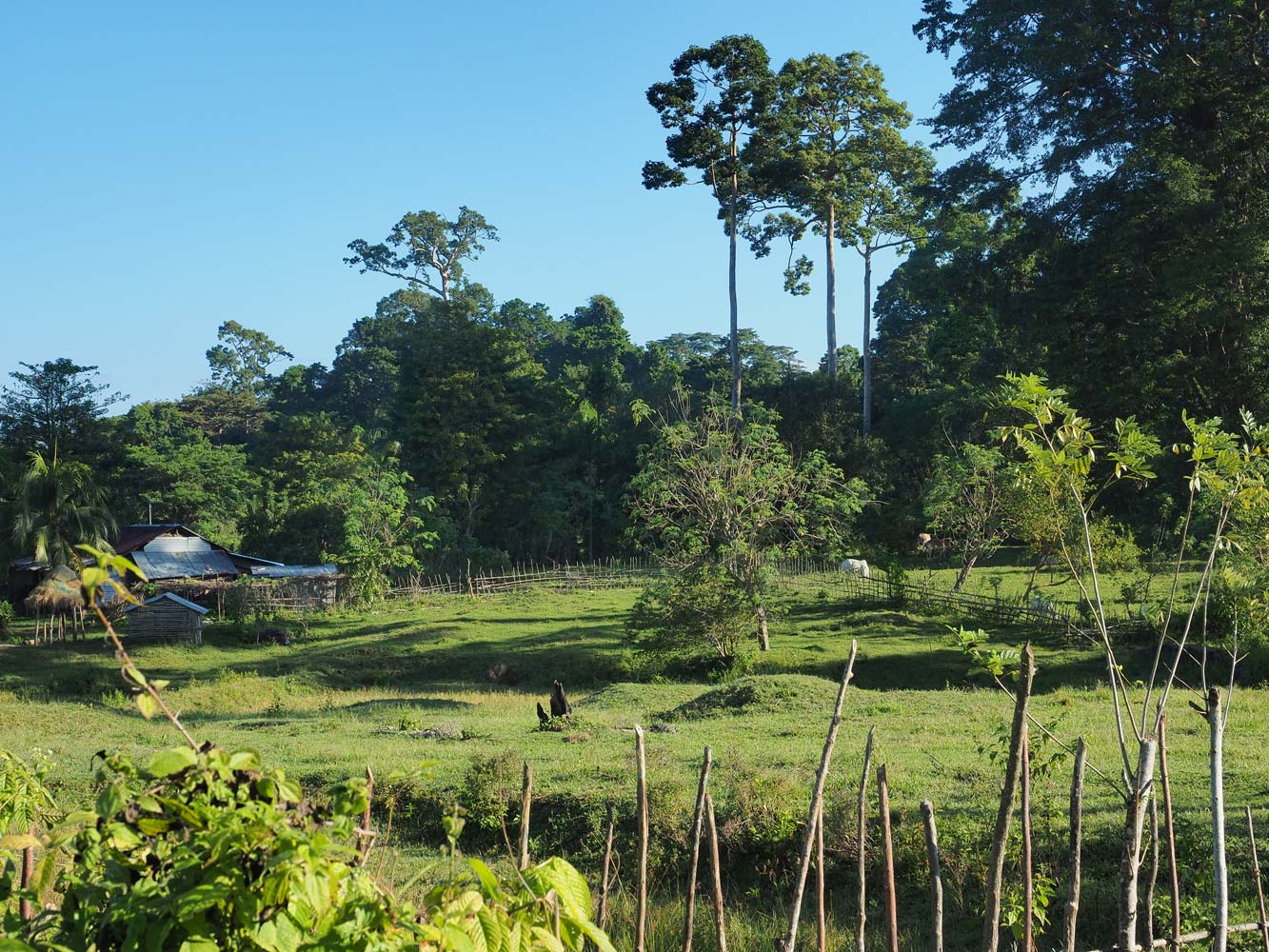
I passed this farm
near the beginning of the trail to Lalaji Beach.
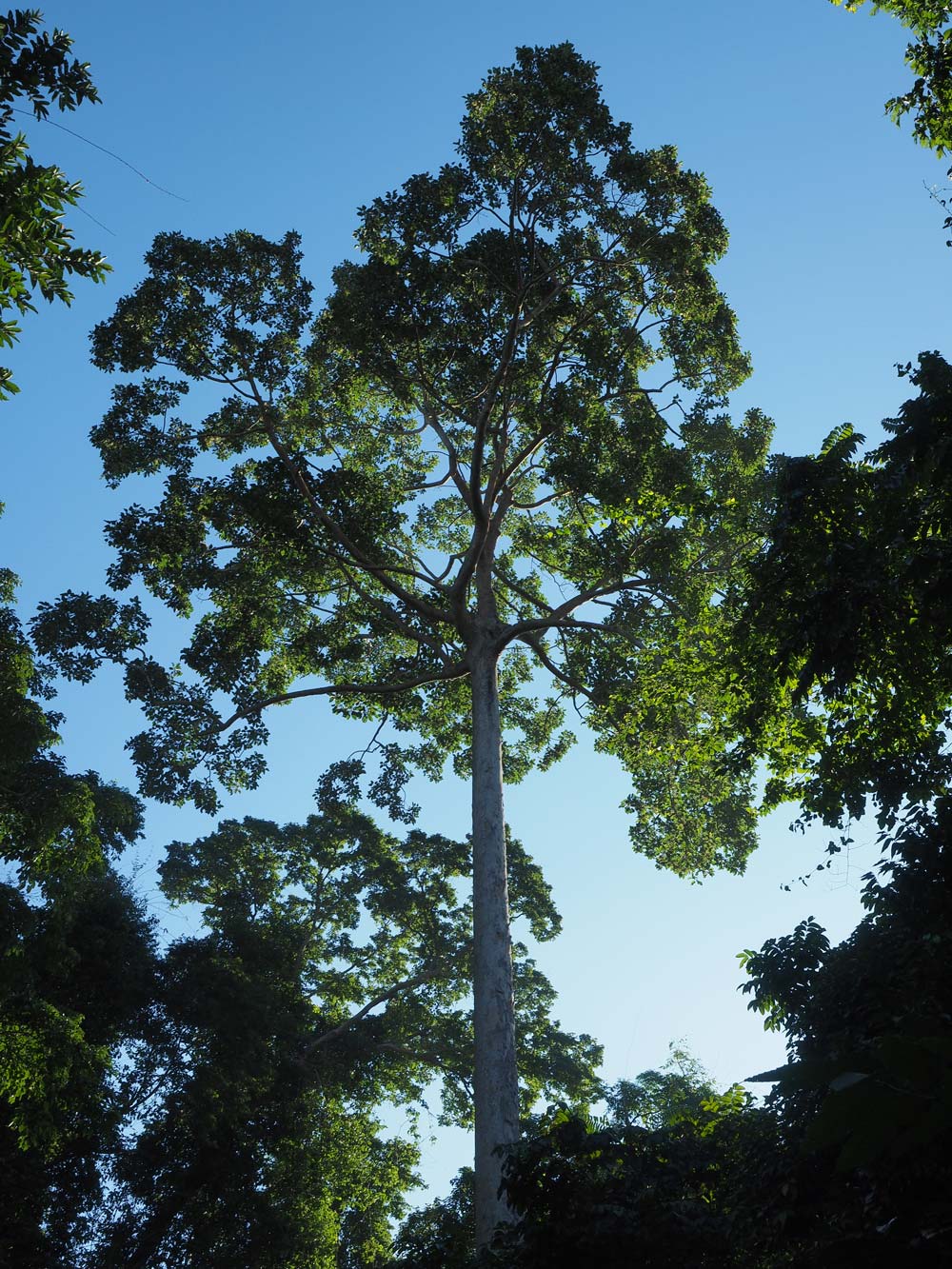
One of the many
giants that towered overhead.
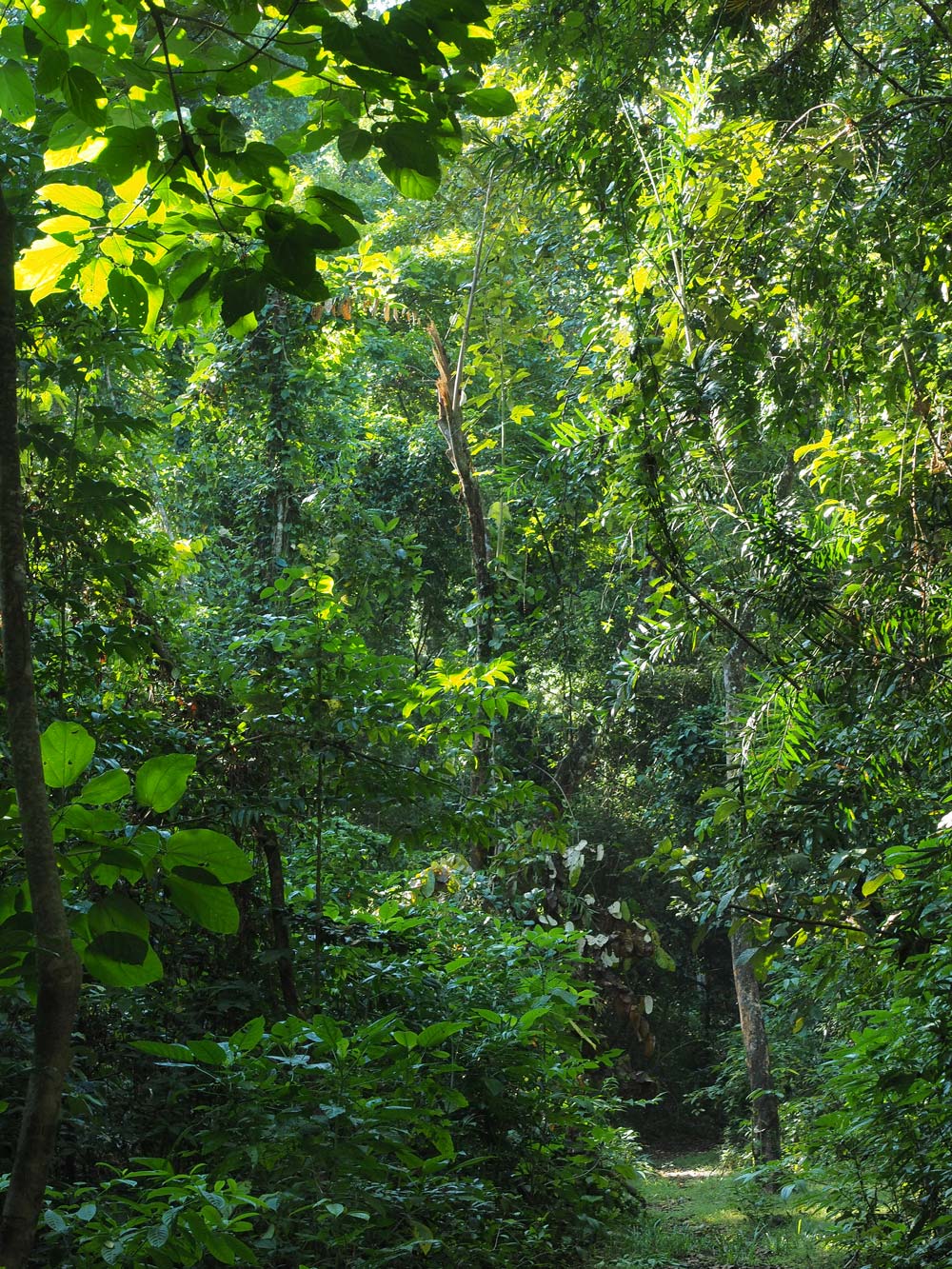
The trail tunnels
into the jungle.

A seed pod deep in
the jungle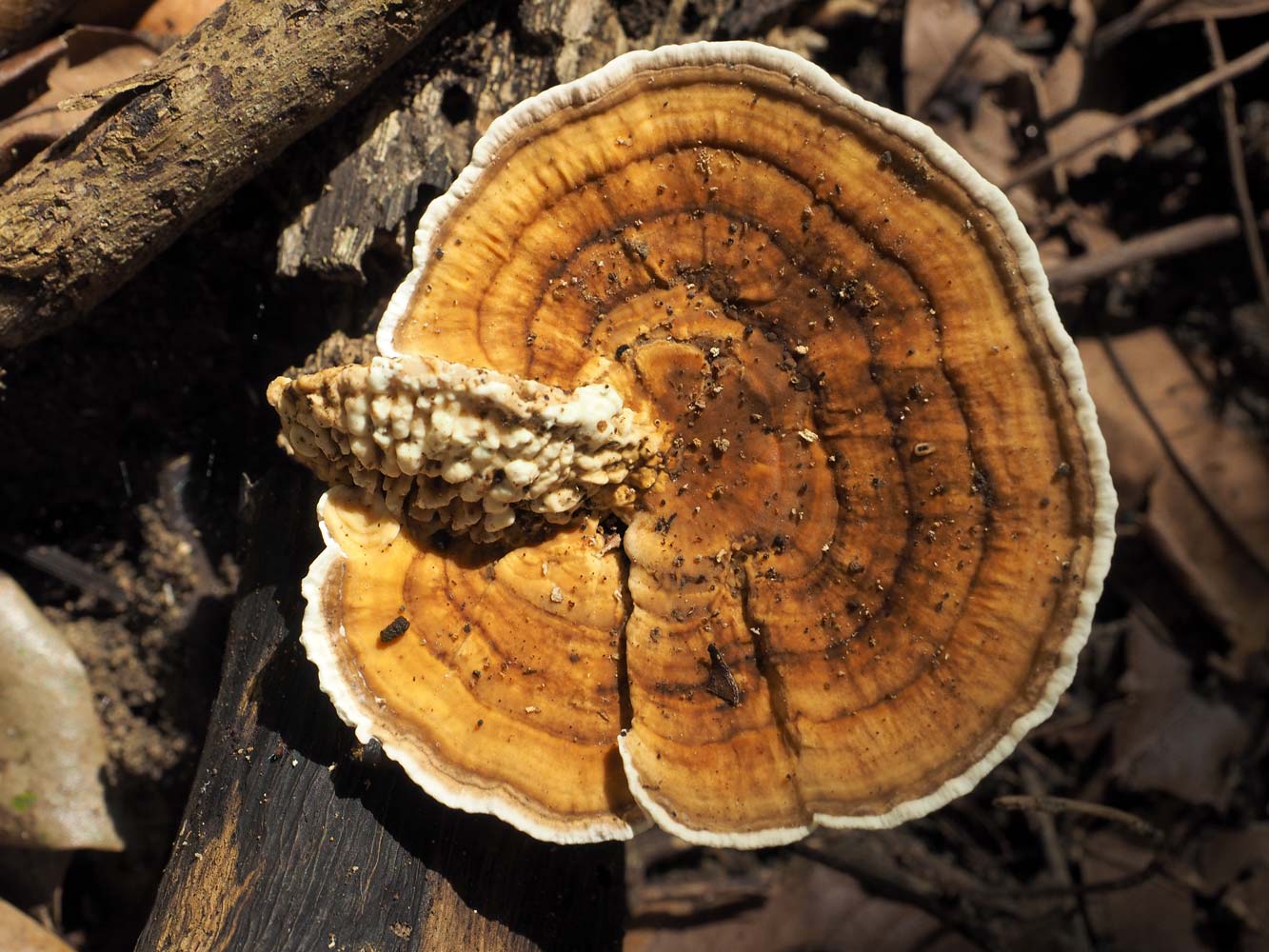
A
fungus recycles a fallen tree.

A hermit crab
wonders what is going on.

Lalaji Beach
17 Dec. Kalipur (Pristine Beach Resort)
I hit the trail a little past 6 a.m.—so not enough time for breakfast—and walked
to the pier, where I got on a rusty little boat at 7 a.m. for the 20-rupee cruise
back across the bay and mangroves to Yeratta Jetty. The morning sun gave a soft
golden glow to the slowly changing scene and I took a lot of photos.
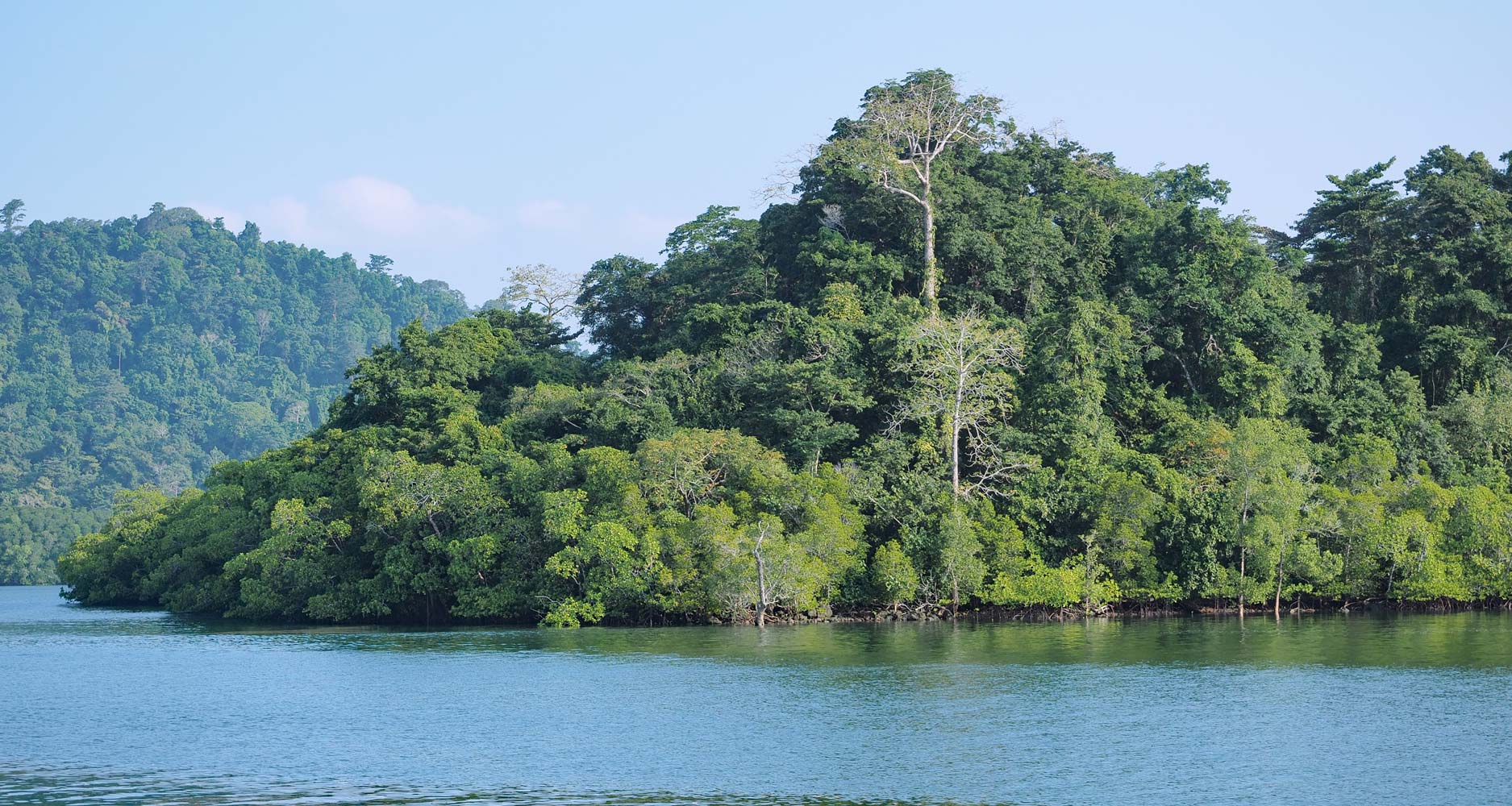
The sun shines from
a blue sky for the journey back to Yeratta Jetty.

Traffic is light
this morning.
And the water becomes like a mirror.
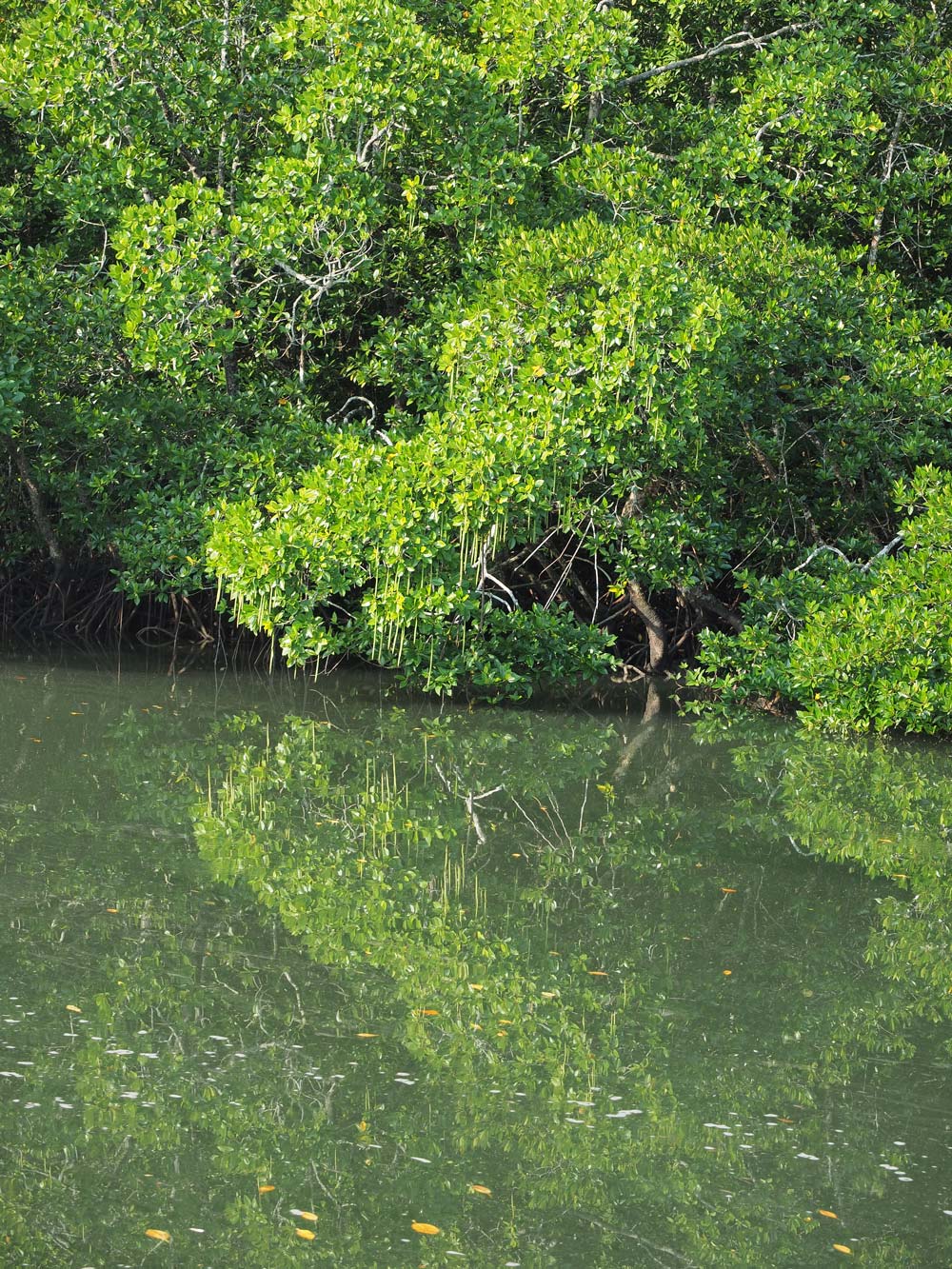
High tide in the
mangroves.
A bus (12 rupees) awaited us at Yeratta for the ride to Rangat’s bus station, where
I learned that the Diglipur bus would depart at 11:30 a.m., so a three-hour wait.
Luckily there’s a ‘canteen’ here and I got a couple South Indian plain dosas and
a plain omelet for breakfast. The bus departed as promised, and I managed to get
a seat close to the front for a smoother ride. I had thought the ‘express’ bus of
three days ago had been slow, but today’s stop-anywhere bus set a new record for
slowness. It swung back into town to pick up more passengers, then detoured to Rangat
Harbor before continuing on the long twisty and hilly trip to Diglipur in North
Andaman Island. North of Rangat Harbor the highway hugged the coast for a ways—the
only section to do so—then turned inland up a valley. Jungle along the way didn’t
look as pristine as farther south, but still had very tall trees and deep hues of
green. The bus made a long detour to Mayabunder, a port town set out on a peninsula
in a large bay off the east coast. Mayabunder is
known for a population of Karen, a Burmese hill tribe brought here during British
times. Before leaving town, we made the seemingly obligatory visit to the bus maintenance
depot to fix something under the bus. A bridge spanned the gap between Middle and
North Andaman islands, so no need for a ferry today. The bus’ long swing through
North Andaman ended just past sunset (5 p.m.) in Diglipur, the Andaman Island’s
second largest town after Port Blair. A parked bus just ahead happened to be going
onward to Kalipur, a beach area said to be the best place to stay. The bus (17 rupees)
took about half an hour to fill, then roared to life and slowly bumped its way northeast
over to the port at Aerial Bay, then south past a naval air station to Pristine
Beach Resort www.andamanpristineresorts.com.
Rain surprised me as I got off the bus. I hadn’t made a reservation—my phone hasn’t
worked since leaving Port Blair—but the resort offered a very nice stand-alone cottage
with bath at 1500 rupees. This was the same price I had paid at Havelock and Long
Island, but here the room is much cleaner and quieter. The resort has more basic
huts as well as fancier rooms with air-conditioning. Two other resorts offer accommodation
nearby: the government Turtle Resort on a hillside across the road and Saddle Peak
View Resort farther down the road. Restaurant staff fixed up a malai kofta with
a spicy tomato sauce along with pullao rice and a garlicky tomato soup for dinner.
On the walk back to cottage, I looked up to find the stars had come out.
18 Dec. Kalipur (Pristine Beach Resort)
Yesterday had been long and tiring, so
I took it easy. I wandered over to the separate dining area for breakfast
and had a free Indian-style poori with vegetables and coconut curry plus milk tea
and bananas. The resort manager Alex was also having breakfast, and afterward—between
receiving frequent phone calls—answered my questions about climbing Saddle Peak
tomorrow and possibly getting a boat ticket for the trip back to Port Blair. The
marine turtle egg-laying season has started, and I hope to see this. Leatherback,
hawksbill, olive ridley, and green turtles swim ashore at Kalipur Beach on evenings
between mid-December and April, and it’s the only place in the world where all four
species lay eggs. Other sights tend to far flung—best done in groups to share costs—by
boat to Ross & Smith Islands (connected by a sandbar) or Excelsior Island, by
road northwest to a mud volcano, and by road and boat south to Alfred Caves. I worked
on sorting last summer’s Ireland photos, then headed out in the late afternoon for
a walk along the beach, following it southwest to a river, then northeast through
mangroves. The tide had gone out, leaving behind a rocky seabed. Craggy Island lay
just offshore with an inviting beach and formidable jungle; it’s close enough that
some people swim there. Lots of tiny gray crabs scurried about, then disappeared
at sunset. Back at the resort I had another fine dinner, this time tomato soup,
mixed vegetable curry, vegetable pullao rice, a frozen coconut custard, and masala
tea.
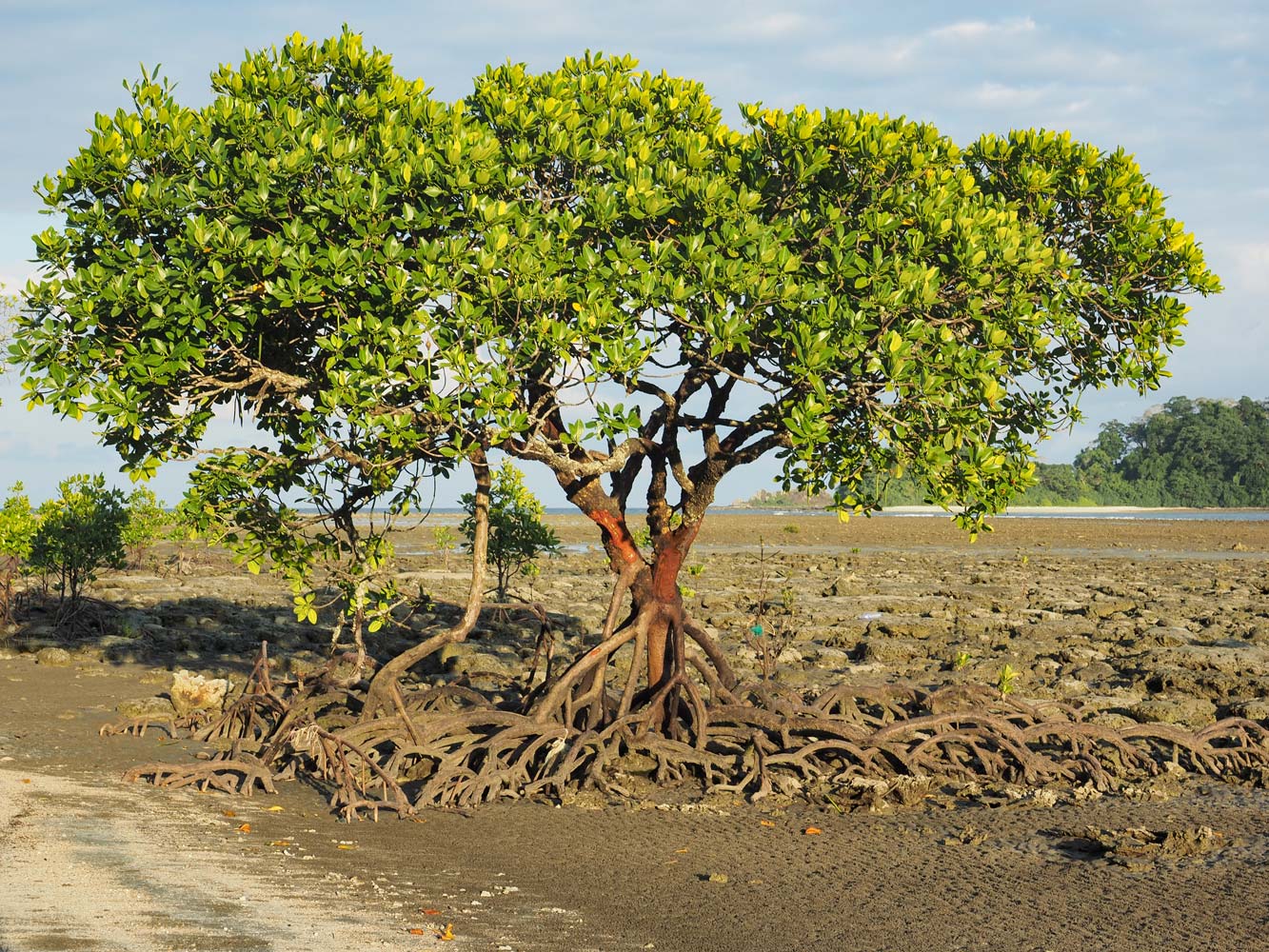
A lonely mangrove
tree near Pristine Beach Resort
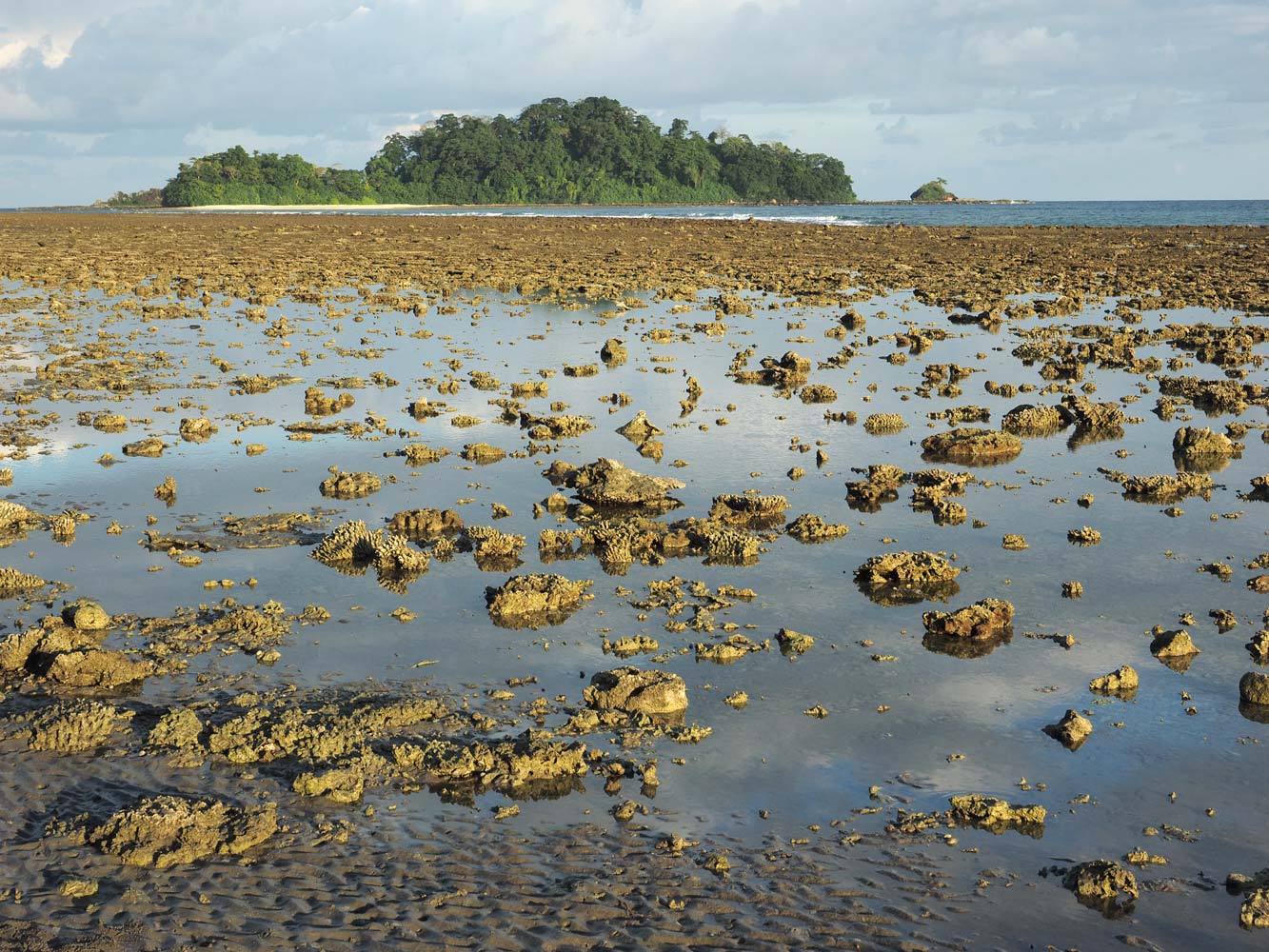
Craggy Island
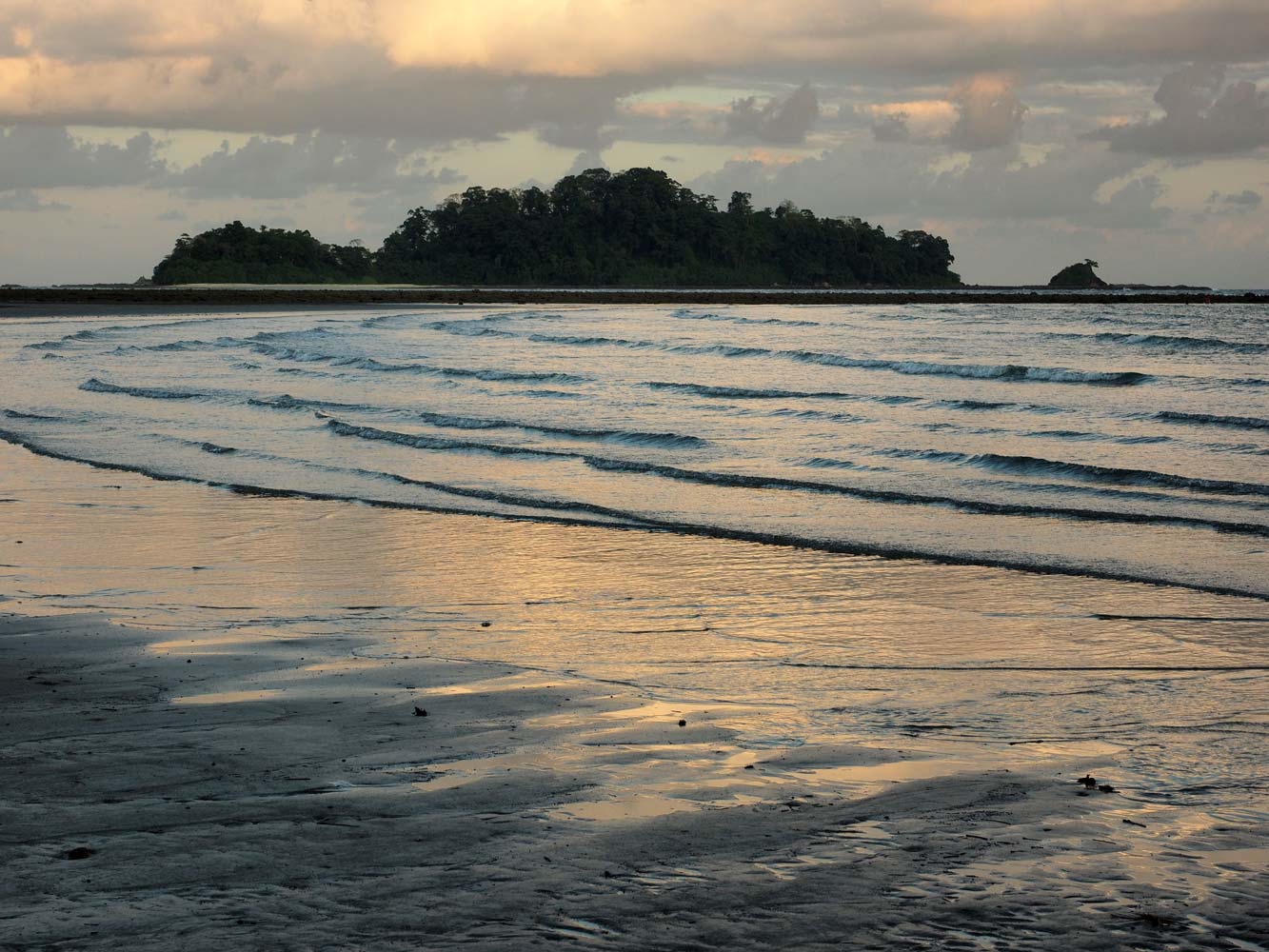
The tide comes
in as the sun goes out.
19 Dec. Kalipur (Pristine Beach Resort)
Saddle Peak at 732
meters stands as the highest summit in the Andaman and Nicobar archipelago and the
centerpiece of Saddle Peak National Park. Its slopes support all types of forests
that grow in the islands, from littoral plant communities of the coast to scrub
forests on the peaks. Of the park’s 188 tree species, 23% grow only in the Andamans
and 40% are found in Southeast Asia but not mainland India.
As promised,
an autorickshaw driver showed up a little before 6 a.m. to take me to the trailhead
for Saddle Peak. The drive past village fields was only 3.7 kilometers, but the
trail is long enough as it is without adding the road distance. On the way we stopped
at a shop for water and snacks. The resort manager said that taking a liter of water
is enough, then refilling at rivers, but I didn’t wish to chance that. Although
my guidebook recommended taking four liters, I brought three and that was the right
amount. I could have hired a guide for 600 rupees, but decided to go solo, and that
was fine. The road ended at Lamia Bay, where I signed in at a park office and paid
250 rupees for a permit, then hit the trail about 6:30 a.m. The trip to the summit
is really two hikes in one—first a nearly level coastal path of 5.1 kilometers,
then the main event of climbing 4.2 kilometers. The coastal trail stayed just inland
in the forest, which has many towering trees, some with leaves in a ‘Christmas color’
of bright red. Early on I passed park buildings and an enclosure for hatching baby
turtles. Cross trails connected inland farms with the seacoast, and I went up a
couple for the views of the mountains. Many streams came down from the hills, and
I had to take my shoes off and wade three of them. Just before the second wading
the trail veered onto the shore, the only place it does so, though it’s easy to
divert at other places to see the coastal scenery.

Saddle Peak rises
high into the tropical sky.

A forest stream

I detour to
this stony beach.

A bright color in
the forest canopy

And turn inland to
this farm for mountain views.
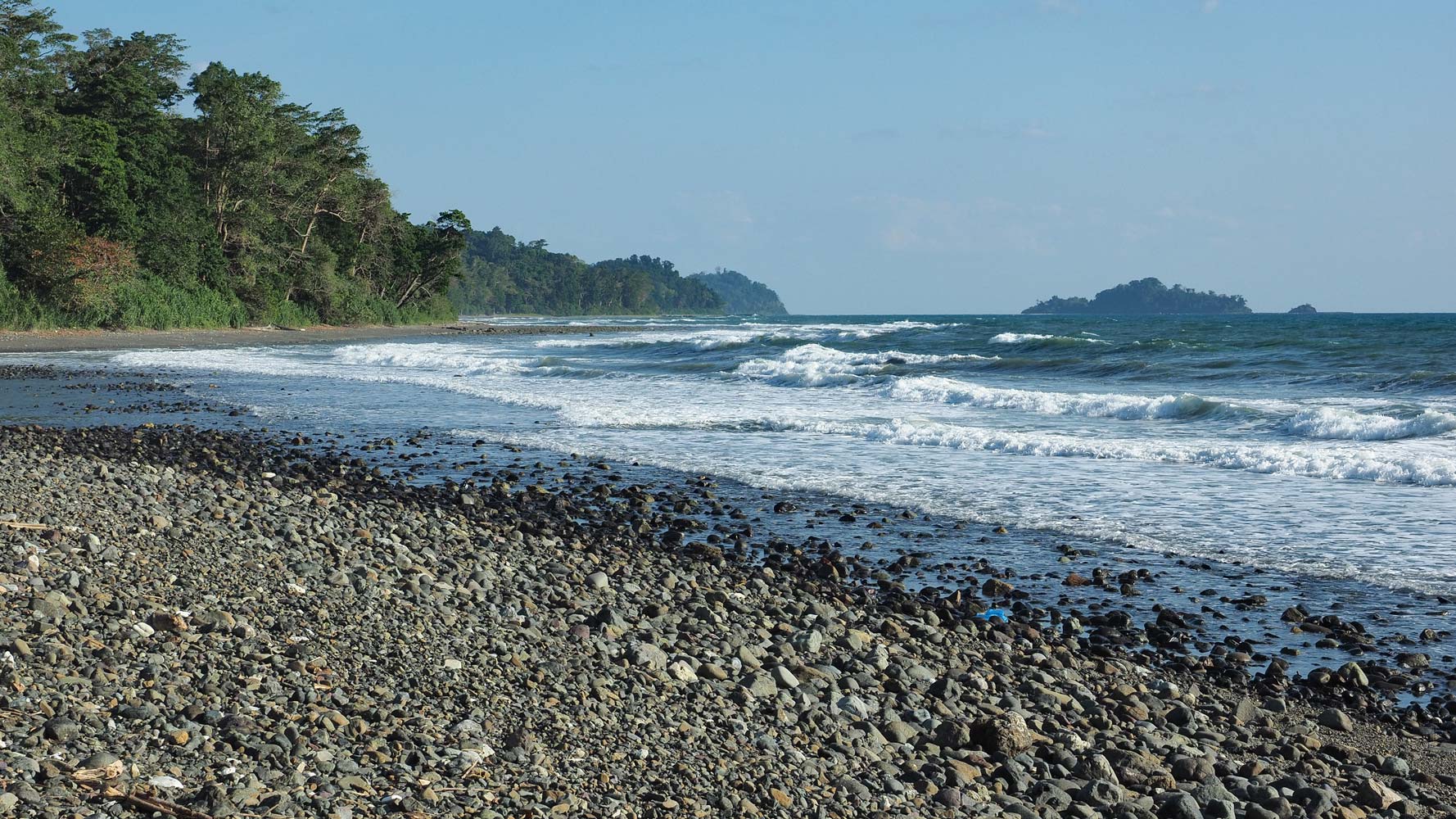
View north from
about where I turn inland to begin the climb.
At the third wading, the largest and prettiest river, the trail turned inland and began its long climb, though the sound of the surf followed me for a long way. Numerous small lizards on the mountain trail replaced the little hermit crabs of the coast. Giant trees, many with massive buttresses, grow on the lower slopes. Higher up spindly trees tightly pack into thickets mixed with bamboo. Only shrubs and dwarf trees hang onto the exposed ridges in the heights. Viewpoints on the high ridges offered hazy views of the coast and islands to the south and the coast and Craggy Island to the north. Sunshine had followed me along the coast, but clouds hung over the mountains and a few bits of rain fell during the climb. The offshore breeze, which had helped keep me cool on the coast, faded away on the climb, then came back when the forest thinned out in the heights. Just before the summit I met a group of trail workers, and I admired their ability to make this long climb and still get a lot of maintenance done. A large Indian flag and tiny Hindu shrine mark the rocky summit at 732 meters, reached after five hours on the trail. Unfortunately the stunted trees block views from the broad summit. On the way down I met a couple from London doing the climb, and the woman offered Ibuprofen in case I experienced knee stress on the descent, but I declined, saying that I’ve done a lot of cycling and have strong knees. The descent to the river went much faster, though I had to be careful not to trip on the many roots and vines across the trail. The crashing surf seemed stronger and louder as I made my way back to the trailhead, which I reached at 3:30 p.m.—nine hours after the start. Although the knees were fine, my legs had become mighty tired at this point, so I was glad to see the autorickshaw driver waiting for me.

I cross this stream
in the jungle.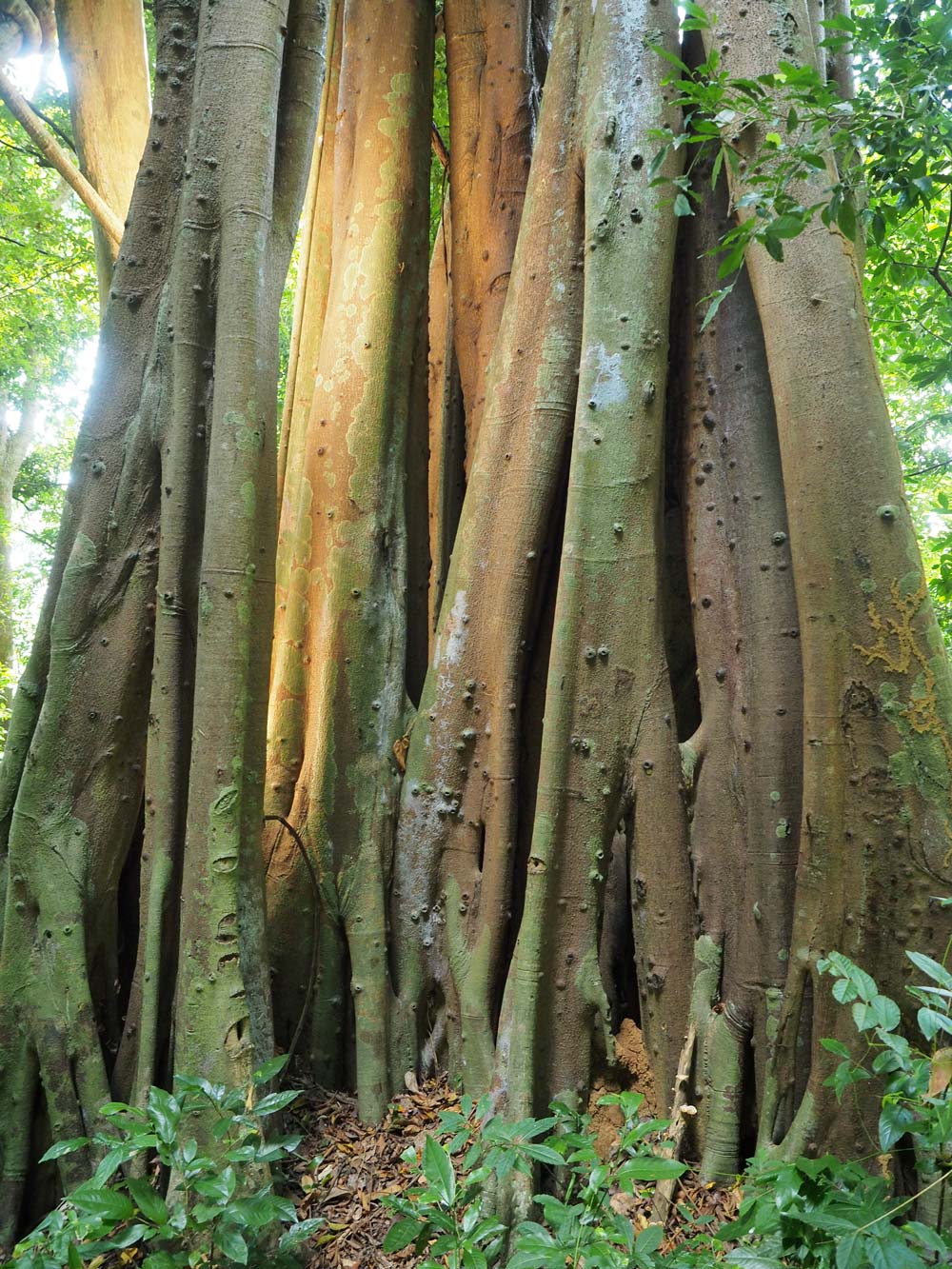
And climb past many-branched ficus trees.
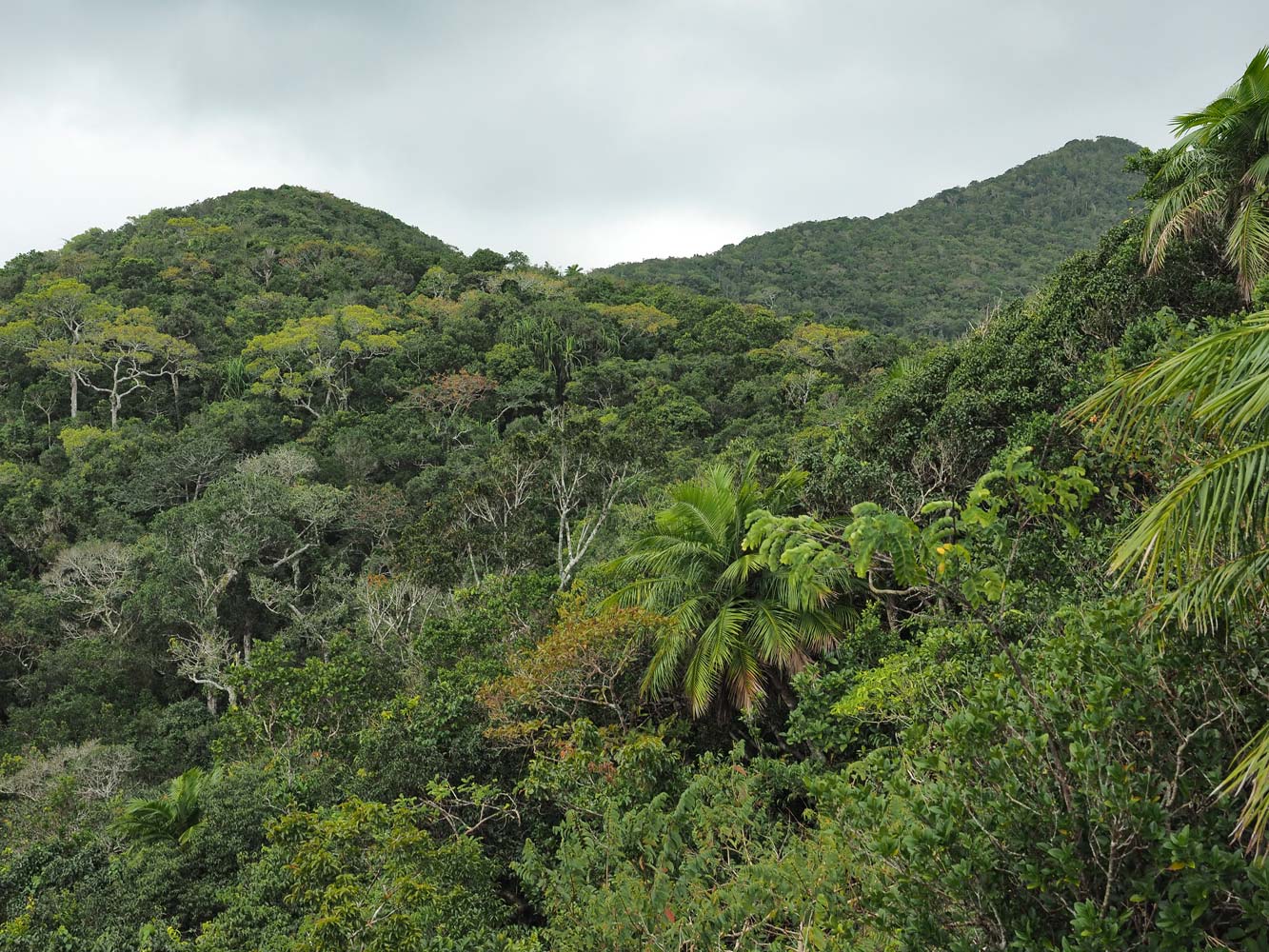
Vegetation changes
as I gain altitude.

You can see Craggy
Island in this view to the north.
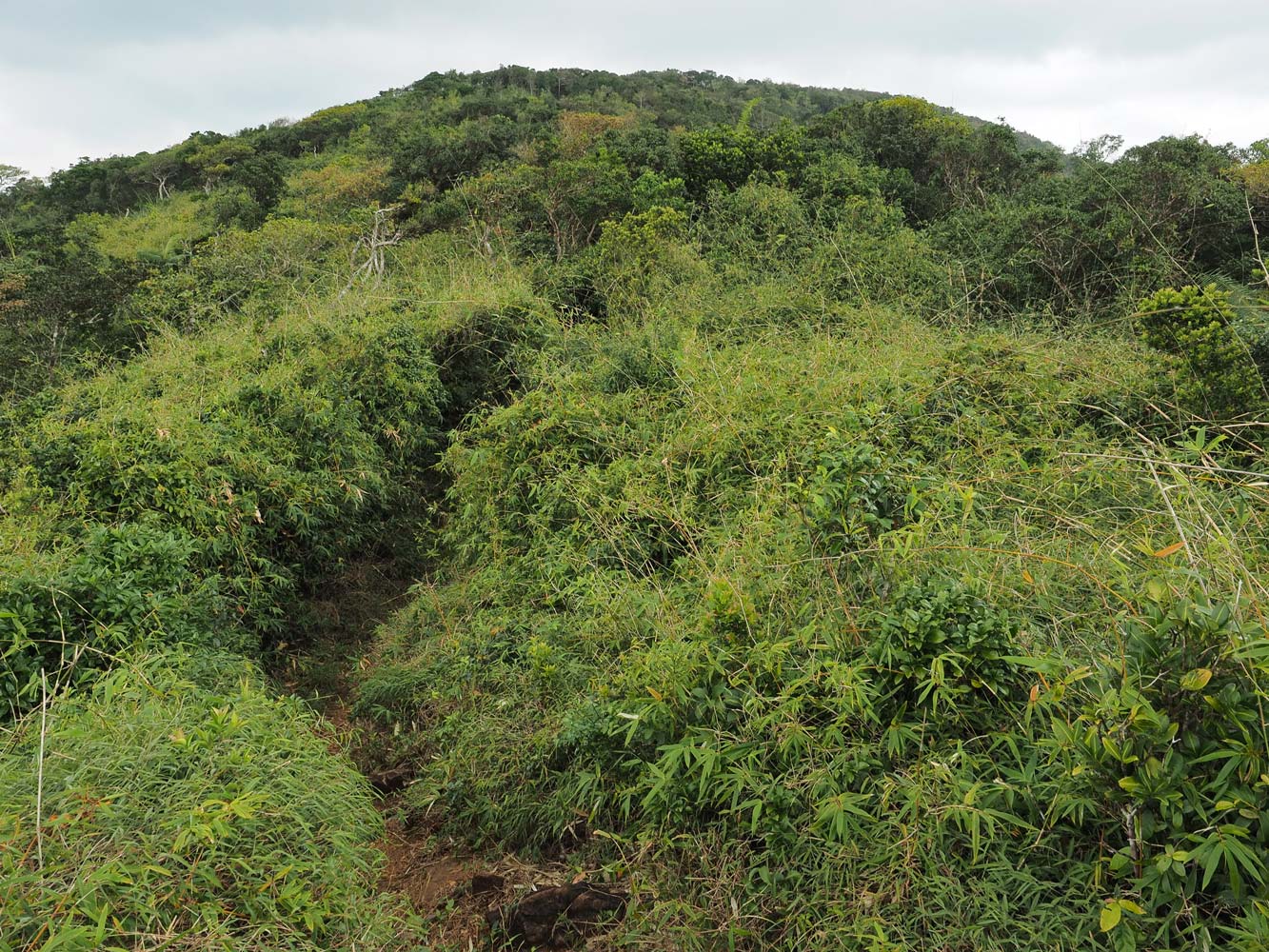
Nearing the summit!

View south from
the summit of Saddle Peak
Back at the
resort I felt more hungry than fatigued, so headed to the restaurant for paneer
pakora, pumpkin soup, omelet, and masala tea. Groups of Indian tourists arrived
today, and I was glad to have the detached cottage. After a rest I returned to the
restaurant for a mutter paneer and vegetable pulao rice dinner, but that got interrupted
with the announcement that turtles had come. Alex led a small group of us out to
the beach where an olive ridley turtle, almost a meter long, was using all four
fins to cover up the eggs she had just laid. Volunteers stood by to dig up the eggs
and put them in a safe place for hatching where hungry animals and humans cannot
get at them. I walked farther along the beach and found two other turtles. One was
about to begin laying eggs in a freshly dug hole and the other turtle was busy digging
a hole. Watching the turtles without disturbing them made for a fine line, and we
weren’t allowed to shine flashlights or use flash to photograph them. None of my
photos came out well.
20 Dec. Kalipur (Pristine Beach Resort)
I had the resort’s Indian breakfast,
this time potato paranthas (fried stuffed flat bread) and tea. The resort provides
free wi-fi at breakfast time (7:30-9 a.m.), so I got to check e-mail and read the
news; at other times wi-fi costs 120 rupees/hour. Alex, through an agent, had arranged
purchase of a ticket for tonight’s ferry from nearby Aerial Bay to Port Blair at
a cost of 1400 rupees for the ticket and 200 for the agent. Travel by sea should
make for a shorter and more comfortable trip than the 12-hour marathon by bus, but
without the jungle scenery. As I expected to take the boat tonight, I checked out
at 9 a.m., then hung out around the resort to do writing and photo sorting. Boat
schedules change frequently, it seems, and change they did—tonight’s ferry has been
postponed until early tomorrow morning—supposedly because strong winds made it more
difficult to avoid small wooden boats at night. While I was having lunch, Alex told
me about the ferry’s delay, so I moved back into my old room. For dinner I revisited
the malai kofta and vegetable pullao of my first night here.
21 Dec.
Port Blair
Last night Alex had been making a giant, one-meter star out of bamboo
and white plastic sheeting, and early this morning I saw it completed and lit up.
At 6 a.m. an autorickshaw driver took me to north to the pier at Aerial Bay, where
I met the couple from London, who had come here from Port Blair by boat and would
be taking this one back. Unfortunately they had booked an onward ferry ticket to
Havelock Island today, which they would miss. They told me that the boat doesn’t
provide food, so before boarding we got paranthas stuffed with some kind of green
bean for lunch. Getting on the boat was easy with just a ticket and passport check
at the pier gate then another at the boat. Expecting an overnight passage, I had
paid a bit more for a berth, but with a daytime trip I felt more comfortable in
a seat. I expected rough seas due to the wind and took a Dramamine before and about
mid-voyage, which worked great because sea sickness never arose. I stayed on the
upper deck for the first part of the voyage to see North Andaman and smaller off-shore
islands glow in beautiful greens under the morning sun and Saddle Peak stand high
in the west. Farther south, the boat left the protection of the offshore islands
and the ride became rougher with pitching and rolling, so I went below. The next
time I came outside I noticed that the lower deck was wet, and soon found out why
when a little wave washed across. The boat had moved far offshore, and North Andaman
Island had largely receded into the haze. During the eight-hour journey I chatted
with the couple from London, rested, and listened to some Buddhist talks. The
London couple told
me of encountering extreme bureaucracy in an excursion to Ross and Smith Islands,
and because an Indian man had recently died while snorkeling there, snorkels were
banned; one could use mask and fins, but not a snorkel, which kinda takes the fun
out of snorkeling. The ride smoothed out under protection of another group of offshore
islands, to the relief of many of the passengers, most of whom had sprawled out
on the floor under the seats or outside on the life-preserver boxes. None of the
Indian passengers seemed to have any interest in food, so that’s probably why the
boat didn’t offer any! I came outside for the last part of the journey and
watched an Indian Navy cruiser—enveloped in a cloud of diesel smoke—slowly pass
in front of us. We docked at Phoenix Bay Jetty among the rusty boats in the harbor. Although
eight hours on the boat was OK, a trip between the mainland and Andamans would have
been 12 times as long and likely a little too much!

Saddle Peak rises
on the left.
A beautiful day at sea with lots of island views
I had thought of
heading to Neil or Little Andaman islands for a few days, but it turned out that
the next available government ferries to those destinations wouldn’t go until December
24th—three day’s time. I thought about taking a private ferry to Neil tomorrow,
but the cost is so high and the check-in such a hassle that I decided against it
and would just stay in the Port Blair area for my last week in the Andamans.
I phoned Aashiaanaa Residency Inn, but no rooms were available tonight. Hotel Lalaji
Bay View had a vacancy, so I took an autorickshaw there and got a tiny room for
700 rupees; it had a private bath but no table or chair. Up on the Excel rooftop
restaurant I stuffed myself with snacks of paneer pakora, tomato soup, fresh-lime
soda, and masala tea. The Excel is a top choice in the Lonely Planet guidebook,
but not for me as smokers made the restaurant unpleasant at times. Later I went
for a walk and had a tasty tomato uttapam at the Annapurna.
22 Dec.
Port Blair
An early morning phone call to Aashiaanaa Residency Inn got a room
for tonight and tomorrow night, so I checked out of Hotel Lalaji Bay View at 8 a.m.
and went upstairs for a big breakfast and some reading and writing; luckily no smokers
this morning. The Aashianaa room, also at 700 rupees/night, suffered a bit from
a bathroom inconveniently across the hall and construction noise next door at times.
I tried getting online, but the internet was too slow to use, so I just sat down
in the lobby and worked on photo editing. In late afternoon I wandered into Aberdeen
Bazaar and had a cheap and tasty Bombay thali at the Milan Restaurant; no Italian
food here though! Clouds ruled the skies for most of the day, making temperatures
relatively cool.
23 Dec. Port Blair
On a pleasant and mostly sunny
day, I had breakfast in the nearby Downtown Restaurant and Café, though it’s not
really downtown, then took an autorickshaw northwest and across a causeway to Chatham
Island to see the Government Saw Mill, an odd tourist attraction run by the Department
of Environment & Forests. I paid the 20-rupee entry, then staff pointed me to
the Forest Museum, where everyone had to take off their shoes to enter. Color photo
exhibits show Andaman sights such as mud volcanoes, caves, beaches, and coral
reefs, while old black-and-white photos depict elephants moving and loading huge
logs. Carved wooden statues, furniture, and knick-knacks—all in gleaming varnish—line
one side of the museum. Outside, I followed signs to a huge bomb crater, now filled
with water, dropped by the British during the Japanese occupation. Indians rebuilt
the sawmill after independence and it’s still running. I got to wander through,
starting at the back of the island where logs are floated into a pen, then lifted
up and dragged through a saw that cuts off big slabs. These then get pushed onto
rollers that bring them to a planer and additional saws to produce the desired size
of boards. Sweet smells of freshly cut wood wafted through the air. The machines
made a lot of noise, but workers didn’t seem to bother with ear protection or hard
hats. I cannot imagine a sawmill in a Western country allowing visitors to wander
through like here! I also walked past drying sheds and poked my head into a shed
with giant metal canisters for pressure treatment, a backup power room, and an electrical
shop. Narrow gauge tracks run all through the area, used for pushing carts of sawn
lumber by hand. From the sawmill I walked along the shore road to a pier where car
ferries did a thriving business. A large passenger ship passed by, and I assumed
that it was headed to the Indian mainland. Tourist boats and small ferries went
back and forth in the bay.

The Government Saw
Mill covers most of Chatham Island (left).
You can see the causeway to the
island on the far left.

Logs have come in
from the shore (left) and await the saws.

Workment operate
the pendulum cross-cut saw, used for end trimming of sawn timber.
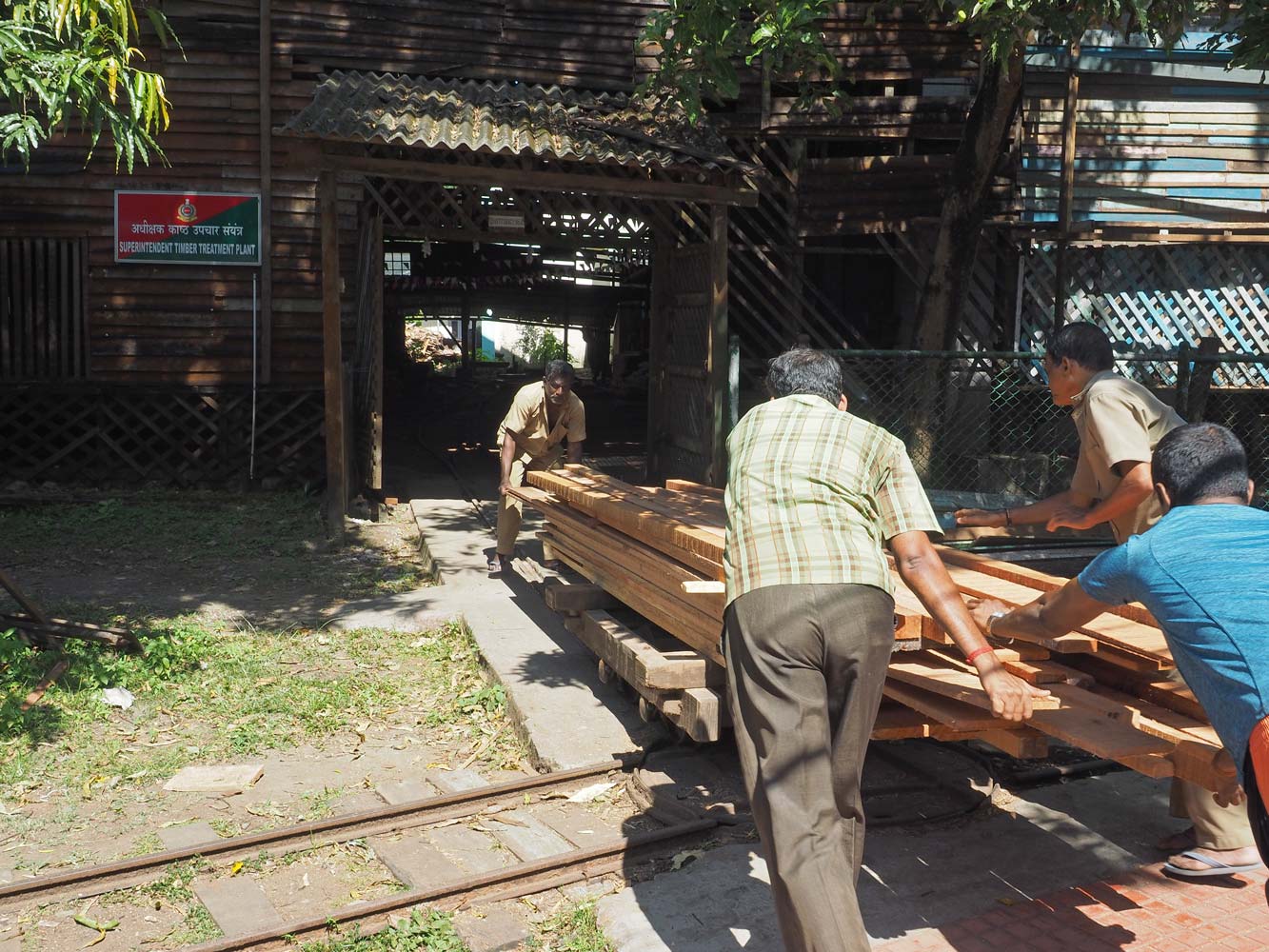
Workers pivot the
rail platform to enter the shed.
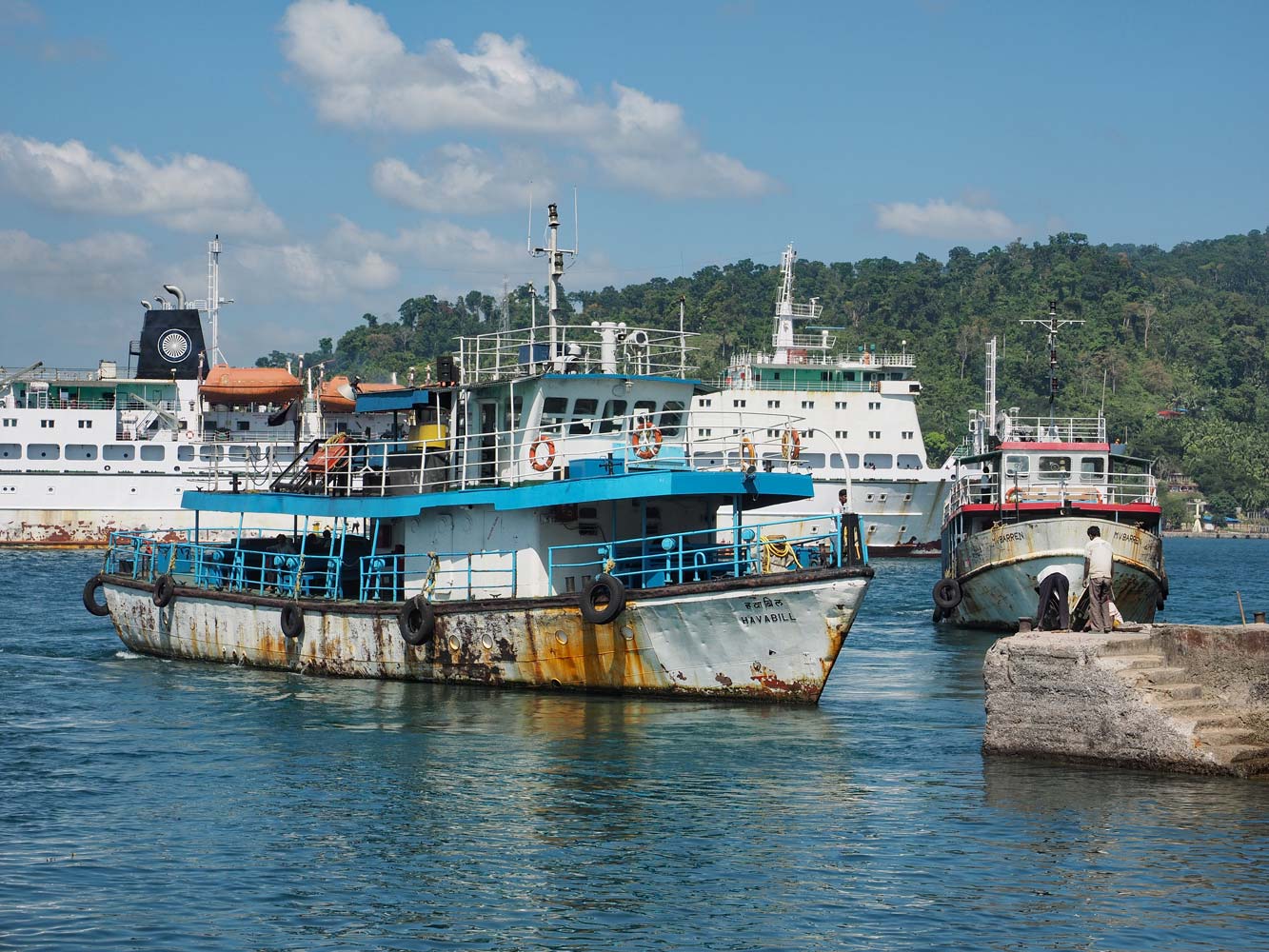
Ferries dock at a
pier on Chatham Island while a large ship passes in the background.
From Chatham Island I enjoyed a stroll on sidewalks back across the causeway, then along the shore to near Phoenix Bay Jetty, about 2 kilometers. Piles of plastic trash had washed ashore, however, detracted a bit from the pretty scenery of the bay and surrounding hills. An autorickshaw got me across town to the Annapurna, where I had a very tasty South Indian thali, which are called ‘meals’ even if you have just one! The thali had seven tiny dishes including vegetable curries, sambar chutney, plain curd (yogurt), and a sweet. A waiter brought free refills of the sambar and curries. Oddly these ‘meals’ are only available at lunch time, not in the evening. The Annapurna seems to have the best food in town, and often attracts a crowd. Next I headed over to Samudrika Naval Marine Museum (50 rupees) with a series of well-done exhibits about the sea life and native tribes of the Andaman and Nicobar islands including one room filled with small aquariums. I spent the rest of the day hanging out at the hotel and working on writing and photo projects. With the big lunch, I just had a snack for dinner.
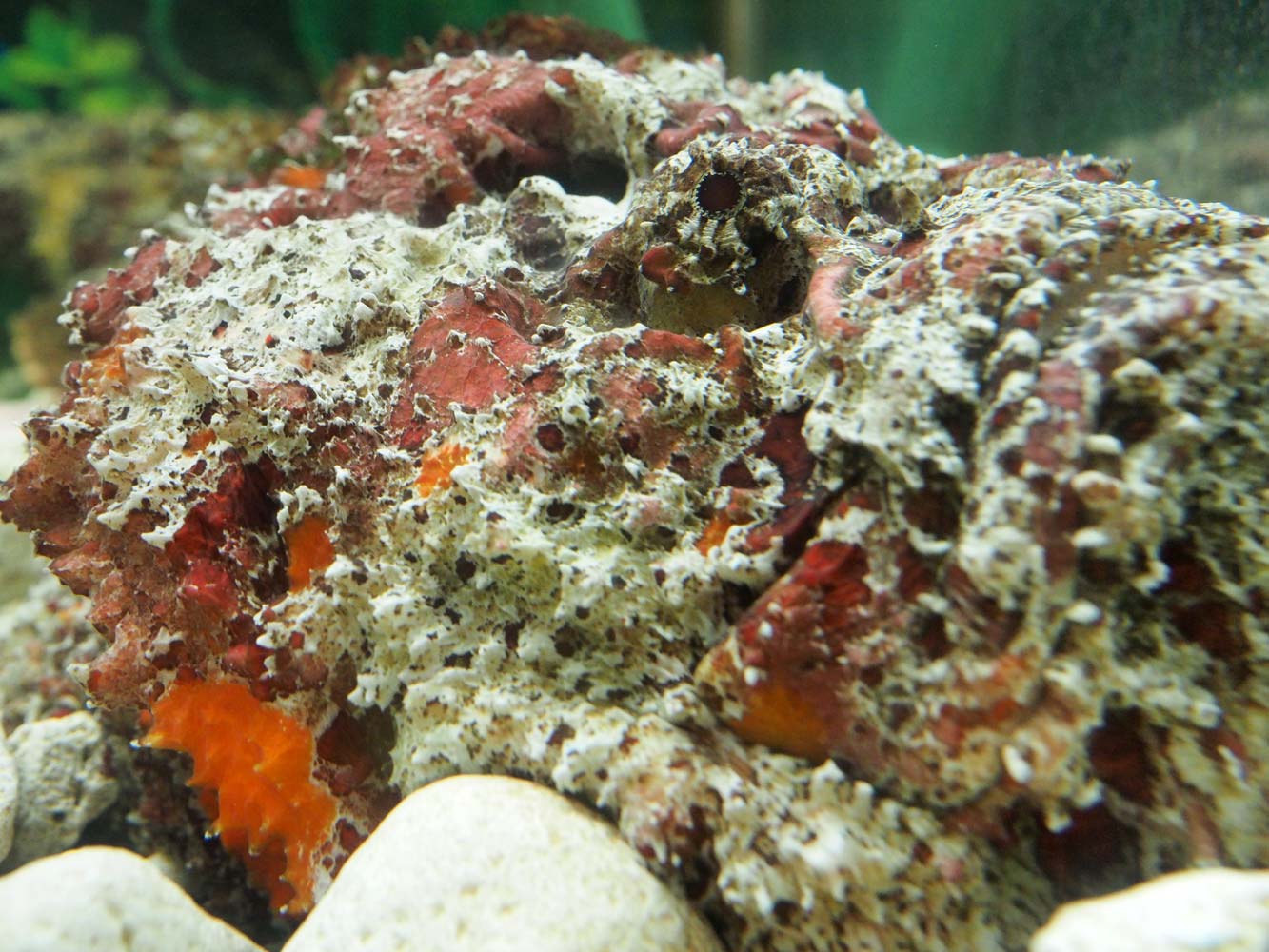
Can you see the
stonefish (Synanceia sp.), the most venomous known fish in the world?
They live in coastal regions of the Indo-Pacific and are dangerous and even
fatal to humans.
Look for the eye near the top; small short teeth fill the
partially open mouth on the right.
(Samudrika Naval Marine Museum)
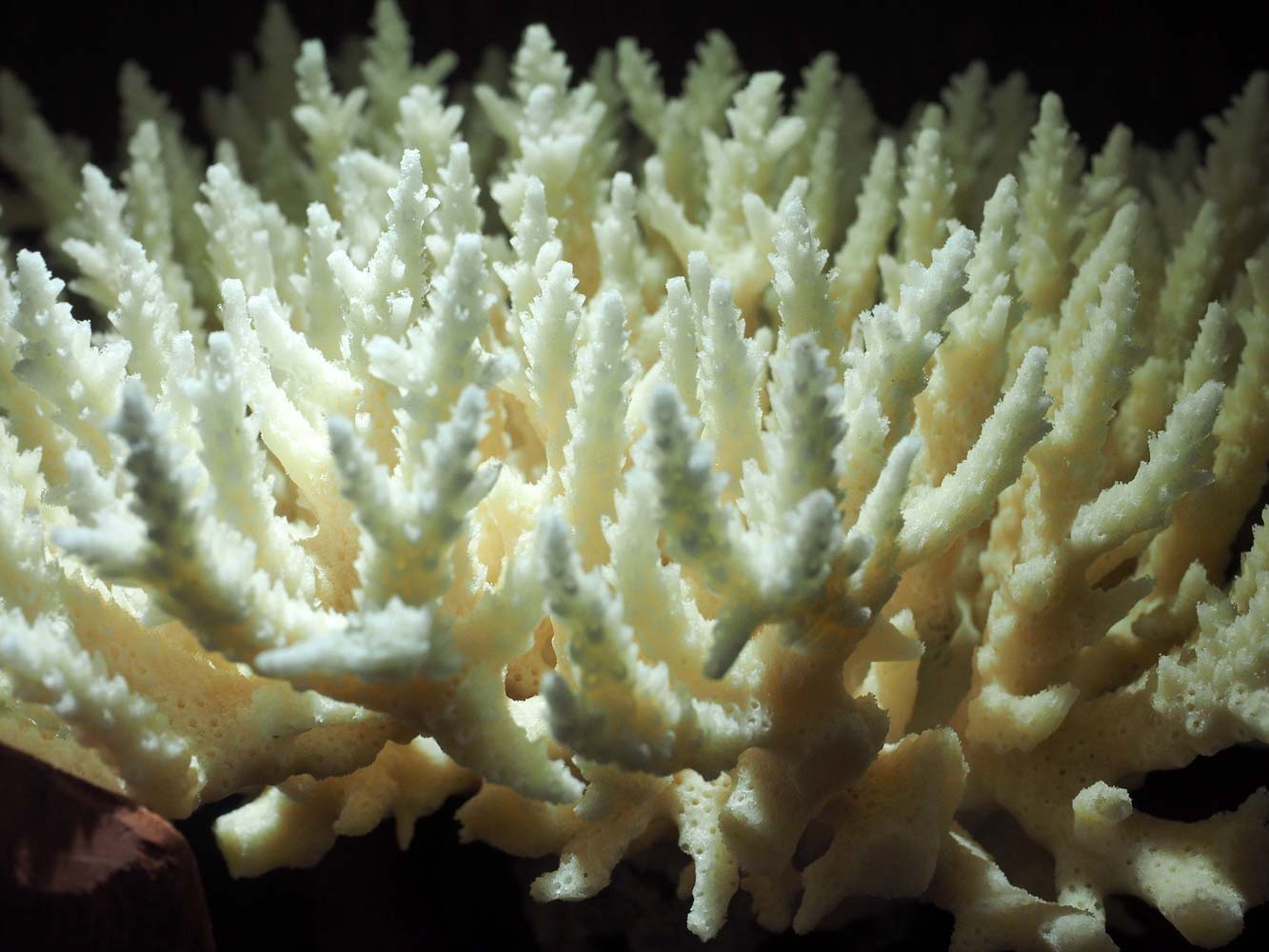
Thicket branching
coral (Acropora latistella)

Digitate branching
coral (Acropora chesterfieldensis)
24 Dec. Port Blair
A quiet day with the usual
breakfast, then I upgraded to a room with private bath and a handy little table.
I returned to the Annapurna for a Bombay ‘meals,’ a mix of North and South Indian
flavors, all good. Many shops in the Aberdeen Bazaar area had closed on this quiet
Sunday. I walked back to the hotel via Marina Park and the coastal path around sunset,
then worked on writing and photo projects, finishing sorting and sizing of the Ireland
photos—more than 2,000 of them!
25 Dec. Port Blair
Merry Christmas!
This is a legal holiday in India despite the very small percentage of Christians
in the country. I finished the big project of sorting and sizing photos of this
year’s European ride with completion of the Wales and England. Next I will post
the best on www.crazyguyonabike.com/doc/EuropeSwing2017
when I get to a place with decent internet. After sunset I walked over to Excel
Restaurant and had a malai kofta dinner. Illuminated paper Christmas stars hung
outside some homes.
26 Dec. Port Blair
I hoped to make a second
visit to Ross Island and its atmospheric ruins of the British settlement, but when
I went to the usual departure point, Aberdeen Jetty, the police had closed the area
off for a mysterious reason. I was sent to a distant jetty, but only expensive tours
and charter speedboats would go to Ross Island. So I gave up on that and came back
to the hotel for breakfast, then some reading, laundry, and an hour of slowish internet.
Rain fell mid-afternoon, the first wet day in Port Blair so far, then drizzled on
and off the rest of the day. Annapurna Restaurant offers three types of ‘meals’
and today I tried the third one, Punjabi meals, with very tasty paneer (cheese),
dal makhani, curd, pickle, roti (flat bread), and a dessert. Of the three, my favorite
is the South Indian meals.
27 Dec. Port Blair
After breakfast I caught
the 8:15 a.m. bus (24 rupees) to Chirya Tapu, an area of jungle, mangroves, and
bays at the southeast corner of South Andaman Island. The bus bumped its way
through Port Blair, continued past the airport, then tackled a long stretch of
suburbs until finally emerging into the countryside, where it followed a valley
past villages and plantations of coconut and betel palms to the coast. Here the
bus ran south along the rocky shore, then turned inland through hills of
beautiful jungle and emerged on a bay at the village of Chiriya Tapu, taking
exactly one hour to cover the 28 kilometers. I climbed a viewpoint for the view
of the calm water and surrounding mangroves and jungle landscapes, then
continued on foot 2 kilometers to Munda Pahar Beach. The pretty route followed
coastal mangroves, headed into small jungle-clad hills—the most beautiful part
of the journey—and dropped back to the shore near the beach. An official at a
registration booth just before the beach asked if I would be swimming (I
wasn’t), then said that swimming isn’t allowed. I assume that’s because of a
do-not-feed-the-crocodiles policy. A large section of the beach and shallow bay
had a fenced enclosure, probably to separate bathers and saltwater crocodiles,
but nobody was using it today. Despite the fine weather this morning, only a few
families wandered about, and I assume that people mainly arrive on weekends. The
tide had gone out, so I easily strolled along the beach and onto the rocky shore
beyond. A trail tunneled into the vegetation where mangroves blocked the
shoreline, but I didn’t go in because it looked like a perfect place for a
crocodile ambush. A small creek formed a long beautiful mangrove-lined pool just
above the beach.

The path to Munda
Pahar Beach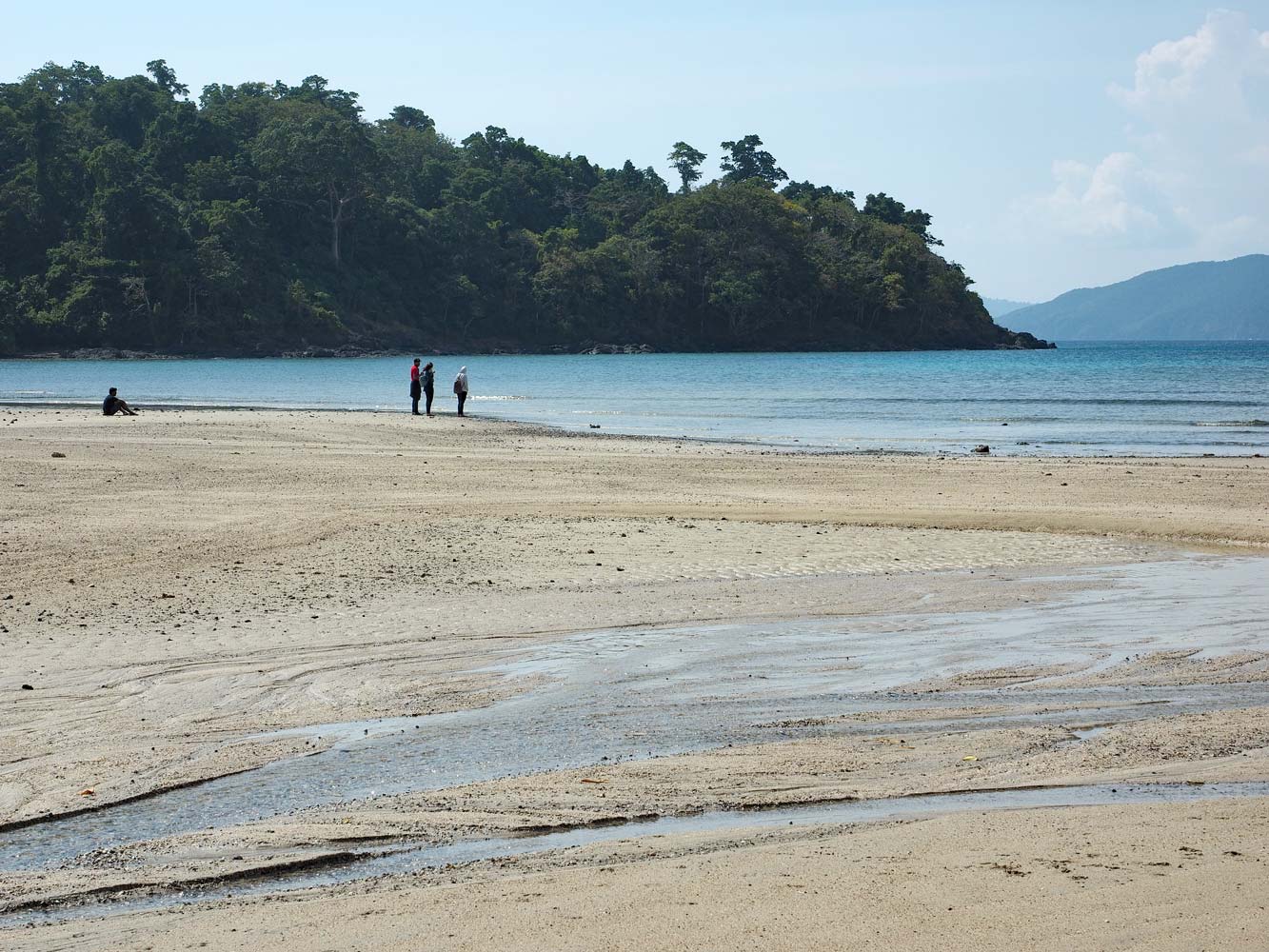
Munda Pahar Beach

Mangroves near
Munda Pahar Beach
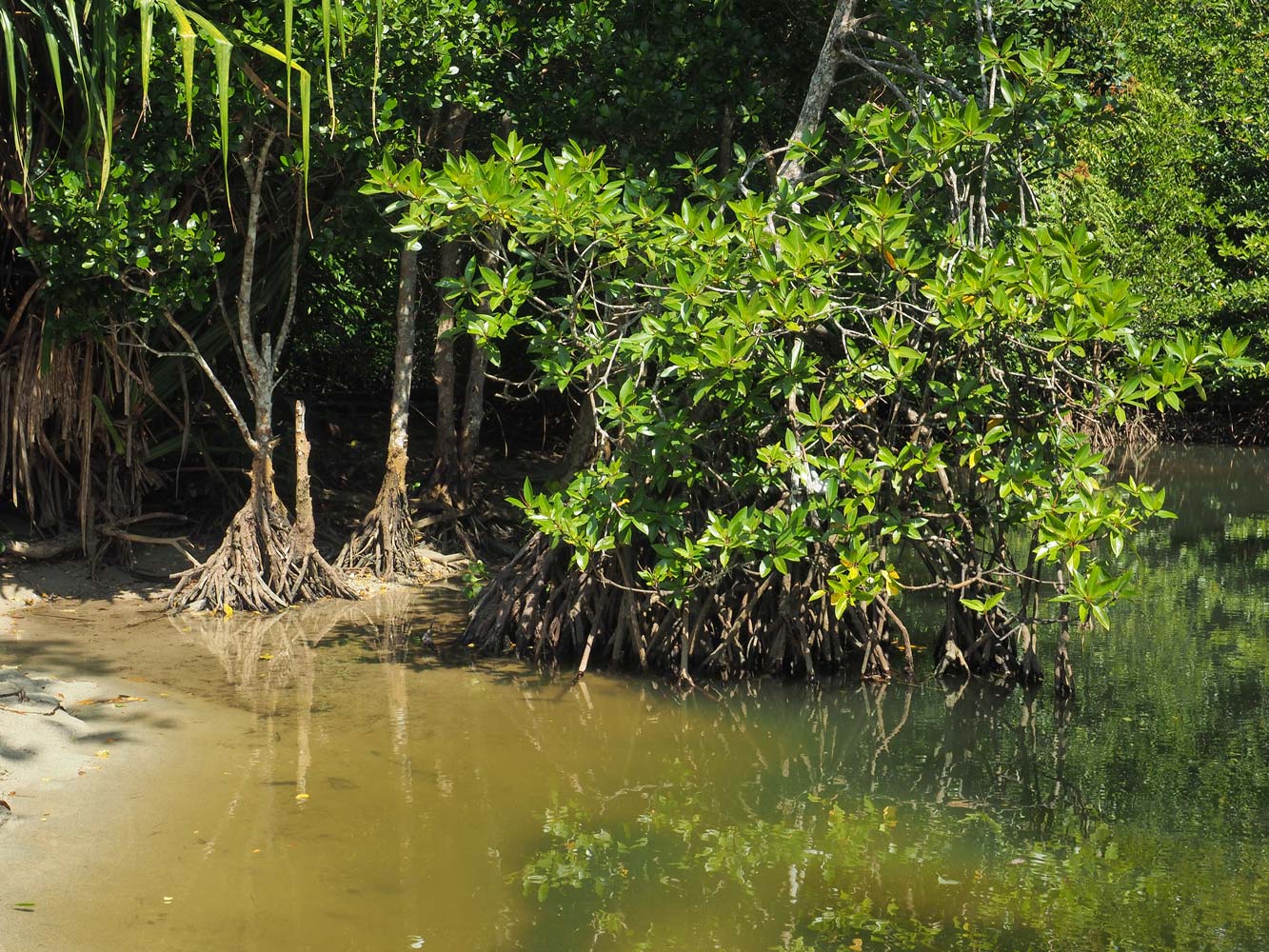
Are there
crocodiles here?

Buttresses help
support this jungle giant.
I retraced my steps back to Chiriya Tapu and turned into the Biological Park (50 rupees), where I followed a big loop on road and trails through the jungle. The first large enclosure harbored saltwater crocodiles, but I had to be patient for three to appear. They like to swim lazily on the surface or hang out in the depths of their murky pool. Most of the bird enclosures, large and full of trees, seemed empty, but I couldn’t miss the noisily cooing Nicobar pigeons. I startled a group of Andaman wild pigs, who had been enjoying their muddy pool. Many of the towering jungle trees had signs, and a forest trail climbed through fine jungle. An enclosure listed tree species, and I learned that a lot of ficus (fig) species live here, often seen strangling an unfortunate host tree. Crab-eating macaques hid from the sun in their spacious and steeply walled home. Deer have several large enclosures, and I saw a group of spotted deer. sFor the return trip I caught the 12:30 bus, though we didn’t get far until the driver stopped to do some tinkering with the engine. Back in town I unsurprisingly headed to Annapurna Restaurant for a South Indian ‘meals’ and a celebratory bowl of butterscotch ice cream. In the evening, as I often do, I headed to the pleasant rooftop Downtown Restaurant & Café for tea and to do writing and editing.